Home Blog PowerPoint Tutorials How to Share a PowerPoint Presentation on Microsoft Teams

How to Share a PowerPoint Presentation on Microsoft Teams

In recent years many remote meeting tools like Microsoft Teams and Zoom have become the norm for regular remote meetings. If you’re new to Microsoft Teams, the chances are you are still finding your way around various options. One of the most common questions a Microsoft Teams newbie might ask is how to share PowerPoint on Teams.
What is Microsoft Teams?
Microsoft Teams is a messaging app by Microsoft for online collaboration and remote meetings that comes integrated with Microsoft 365. It provides a real-time workspace where end users can collaborate via chat, Teams Channels, Live calls, etc. Microsoft Teams also integrates with other Microsoft products like PowerPoint and OneDrive, enabling instant file sharing via the cloud.
Why use Microsoft Teams to Present Your PowerPoint Presentations?
Many organizations use Microsoft Teams for online collaboration and remote meetings. Organizations with integrated Microsoft products like its Windows operating system, Microsoft Office, and Azure Active Directory prefer Teams as the primary internal and external communication app. Organizations use Microsoft Teams to provide secure accounts to employees, with two-factor authentication and data encryption. These accounts are integrated into the Active Directory, providing scalability and control for IT administrators to offer people within an organization an online collaboration platform that can be securely used within the limits of the organization’s data protection policies.
While there are many alternatives to Microsoft teams, such as Zoom and Google Meet, the integration of teams with other Microsoft products, such as Azure, Microsoft Office apps, and OneDrive, makes it attractive within a secure enterprise environment.
How to Present PowerPoint in Teams?
How to present your PowerPoint slides on Microsoft Teams, let us tell you there are at least two methods for sharing presentations. This includes sharing a PowerPoint file directly and presenting your slide deck before one or more meeting participants, or perhaps PowerPoint templates or Google Slides templates to help a colleague design a slide deck.
How to Attach and Share Your PowerPoint Slides on Teams
To share a PowerPoint file on Microsoft Teams, go to an ongoing conversation or meeting window and click Attach files . This will provide you with the option to either fetch a file via OneDrive or from your device. This option can be used for sharing PowerPoint files and other types of files, such as documents, spreadsheets, videos, compressed files, etc.
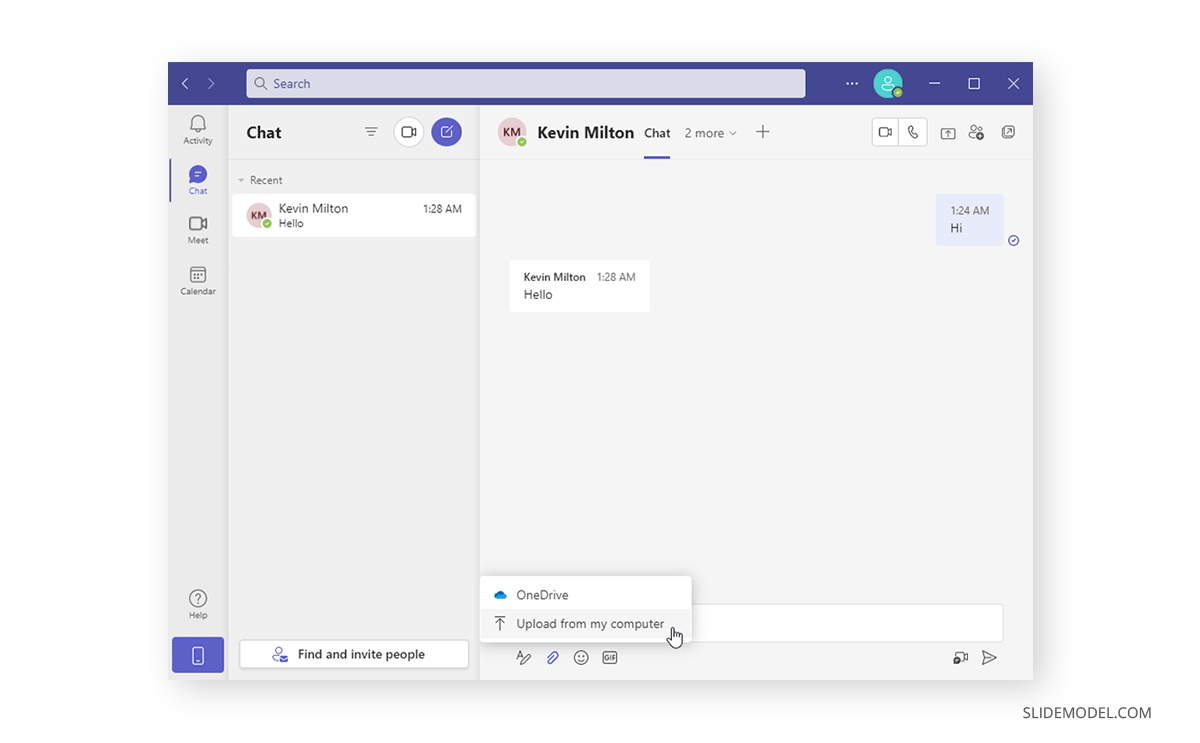
When sharing a file, you can add a message optionally before hitting Send .
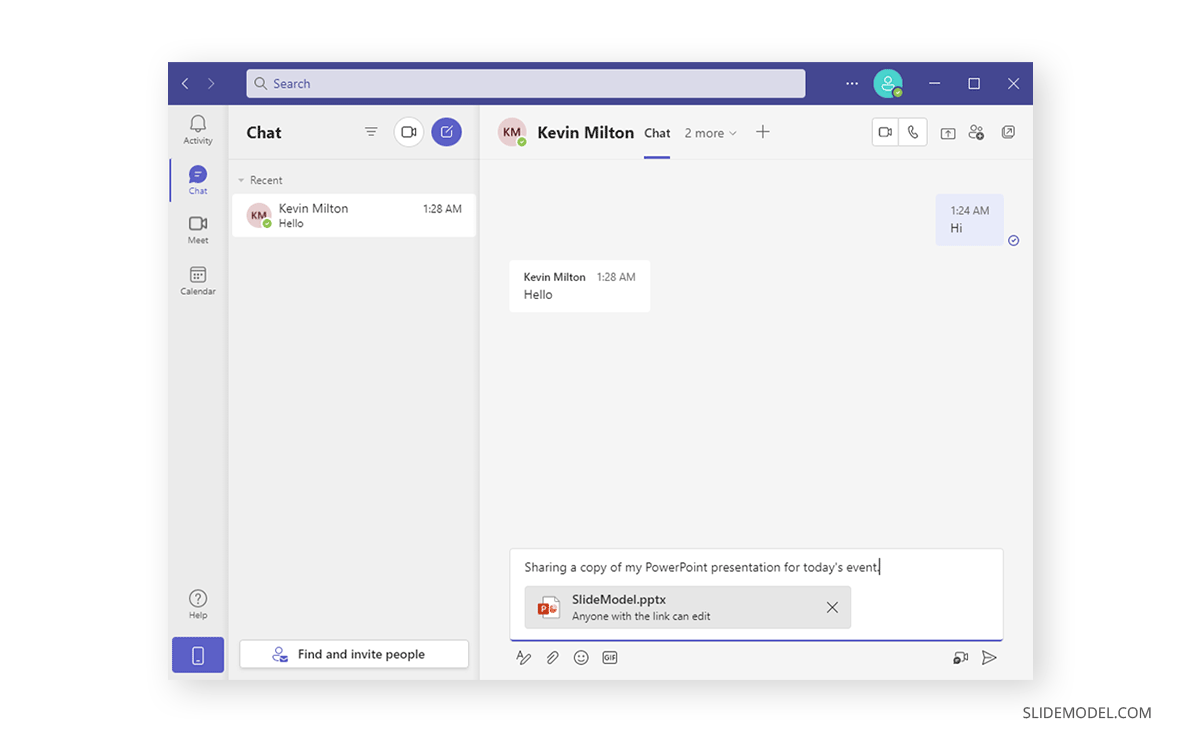
The recipient and the sender can download the file, open it in a browser, or copy the file link for further sharing.

How to Present Your PowerPoint Slides on Teams
Method #1: use the share button in powerpoint.
You can also directly present your slide deck via Microsoft Teams by sharing your screen to start a Live presentation during a remote meeting instantly. Suppose your organization uses Microsoft Teams regularly. In that case, the chances are you will be using it for presentations during remote meetings; therefore, it’s essential to know how to use the screen-sharing option to present online.
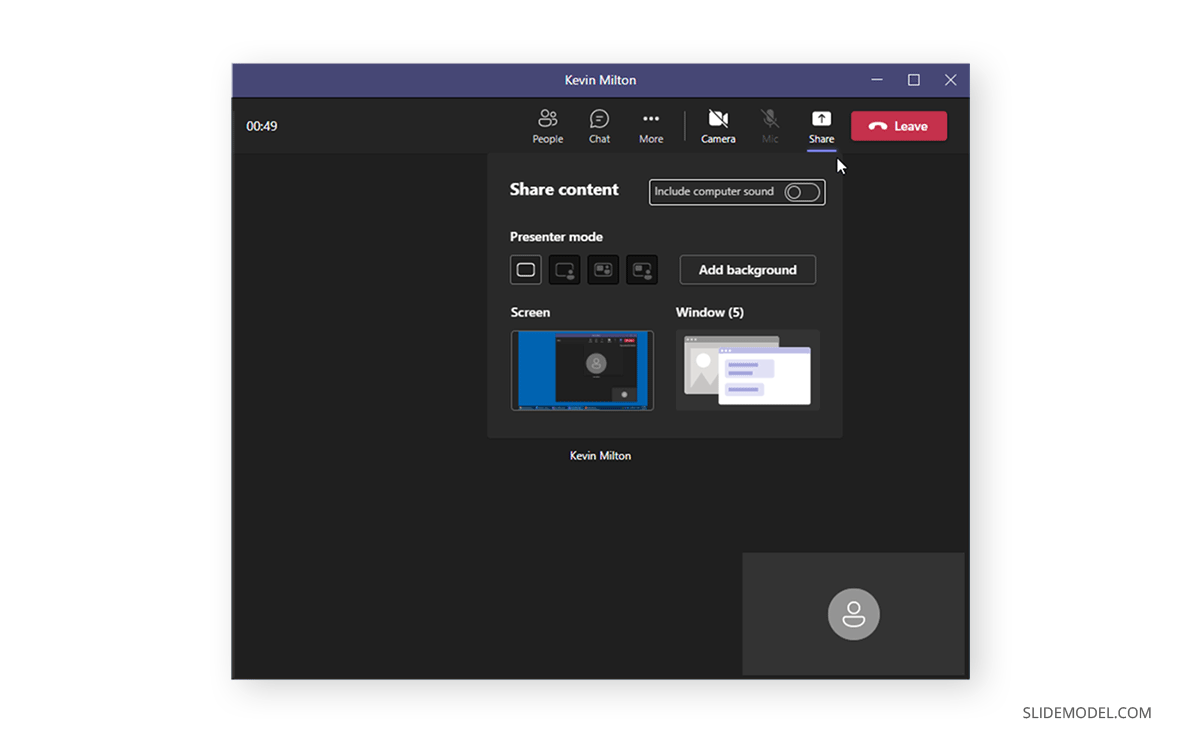
Method #2: Share Screen to Present a PowerPoint Presentation
Another way to present a PowerPoint presentation on Teams is by sharing the screen with your audience. If you share your screen, this will show the audience whatever is visible on the entire screen on your device.

Pros of sharing your screen with the audience to present a presentation:
- It is easier to activate
- You can easily switch to other windows besides the PowerPoint presentation and also share them with the audience
Cons of sharing your entire screen on Teams for presenting:
- If you have confidential data in other windows, you may want to avoid switching the windows and keep only the Slideshow window in front.
- You may accidentally switch to other windows, and your audience can lose focus of the presentation.
Method #3: Share PowerPoint Window to Present Your Slides
If you intend to hide parts of your screen, you can simply share the relevant PowerPoint window so that your audience can only view the presentation. During a Live call, click the Share button and select your screen or window to share.
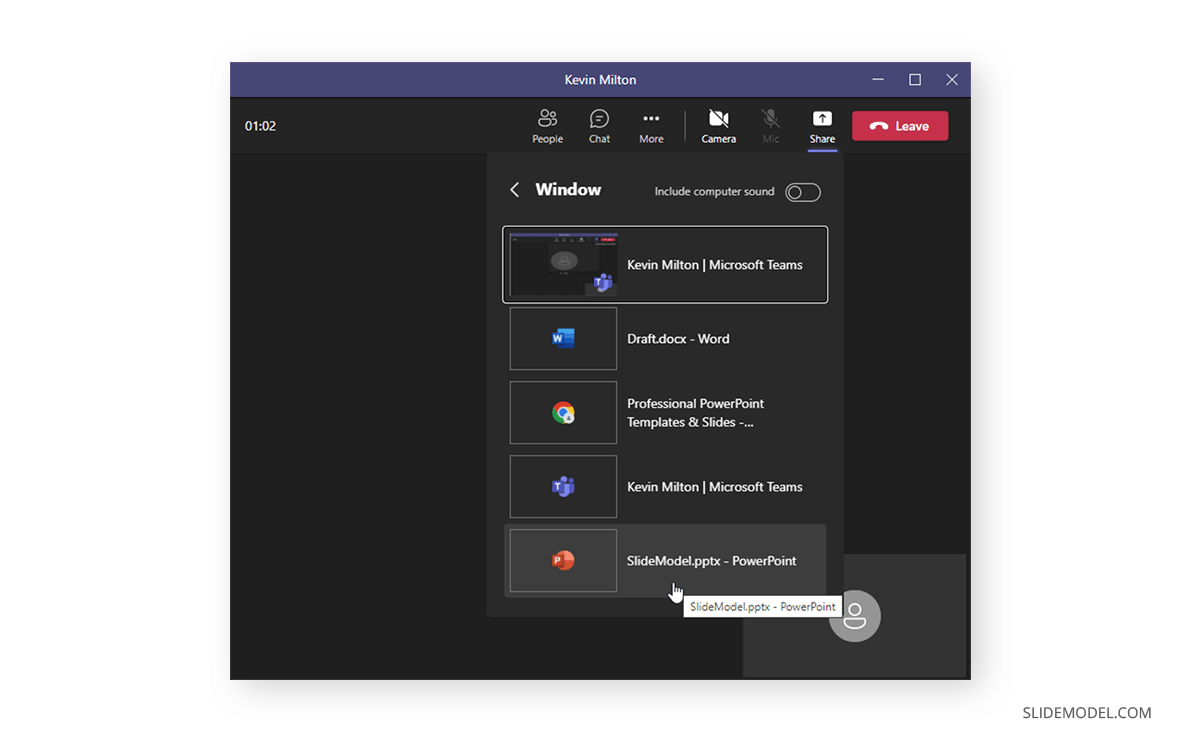
5 Features to Make the Most from Your Microsoft PowerPoint Presentation Sharing in Teams
Microsoft Teams offers a wide array of features that make it a robust remote meeting and online collaboration app since it leverages the full force of Microsoft 365 and other Microsoft products.
1. Translate Slides into a Different Language
This is a private feature that individuals can use to translate slides in their language instantly. As a presenter, you can ask your audience to use this feature if they deem it convenient to help bridge a gap that might exist due to a language barrier.
Slides can be viewed in a different language via More actions > Translate Slides . From the drop-down list, you can pick a preferred language.
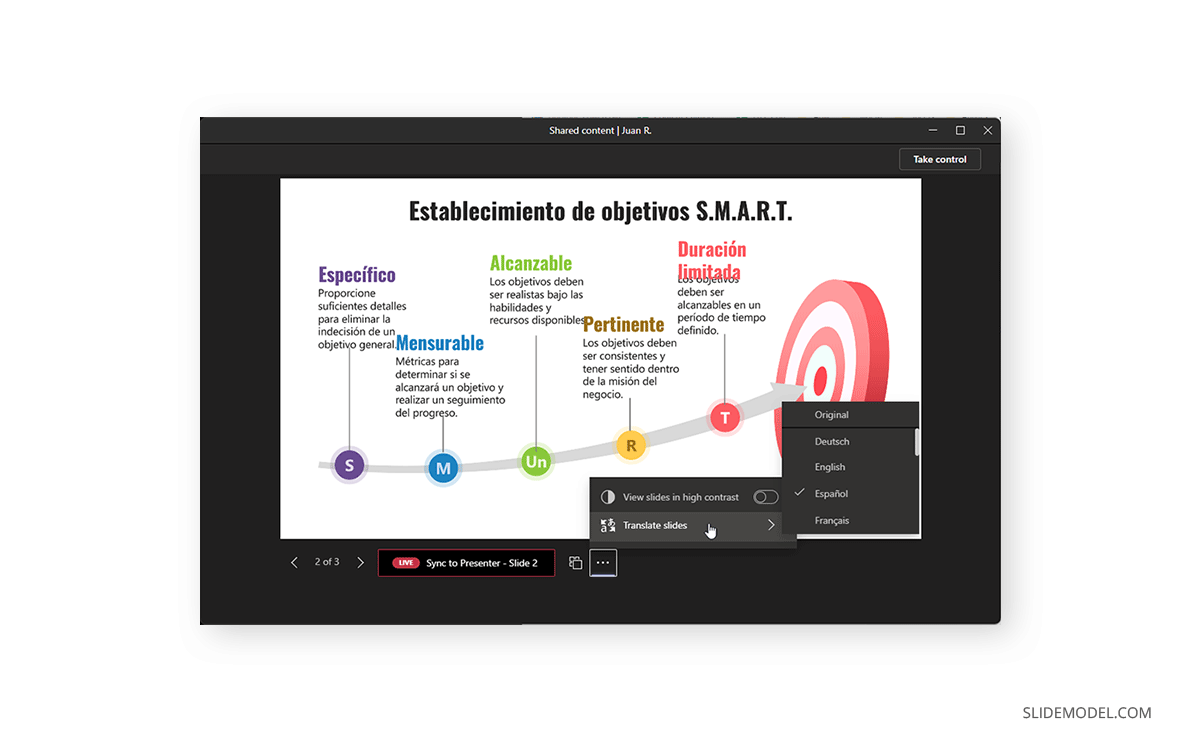
2. Use Live Captions
Microsoft Teams supports Live Captions / Closed Captions (CC) to help persons with disabilities, including those suffering from hearing impairment. Closed Captions can also be helpful for people to translate or view text in a preferred language.
Turn on Live Captions: To enable Live Captions on Teams, go to More options > Turn on live captions . Translate Spoken Language: To translate Live Captions, go to Captions settings > Change spoken language .

Turn Off Live Captions: You can turn off Live captions anytime via More actions > Turn off live captions .
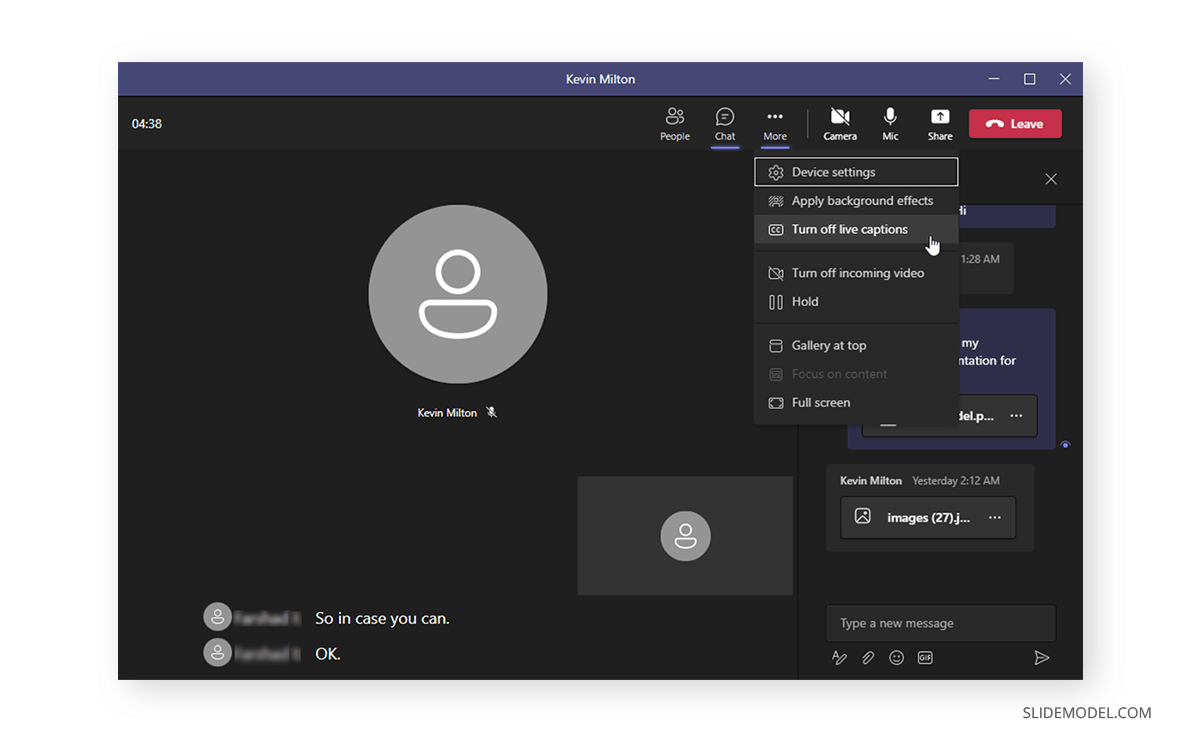
3. View Slides in High Contrast
Viewing slides in high contrast on Teams can have several benefits. For example, it helps you focus on the content and is also helpful for people with visual impairment. To configure your slides to appear in high contrast, follow the steps below:
1. Launch your PowerPoint presentation.
2. Click on the Present tab at the top of the window.3. Go to More action > View slides in high contrast .
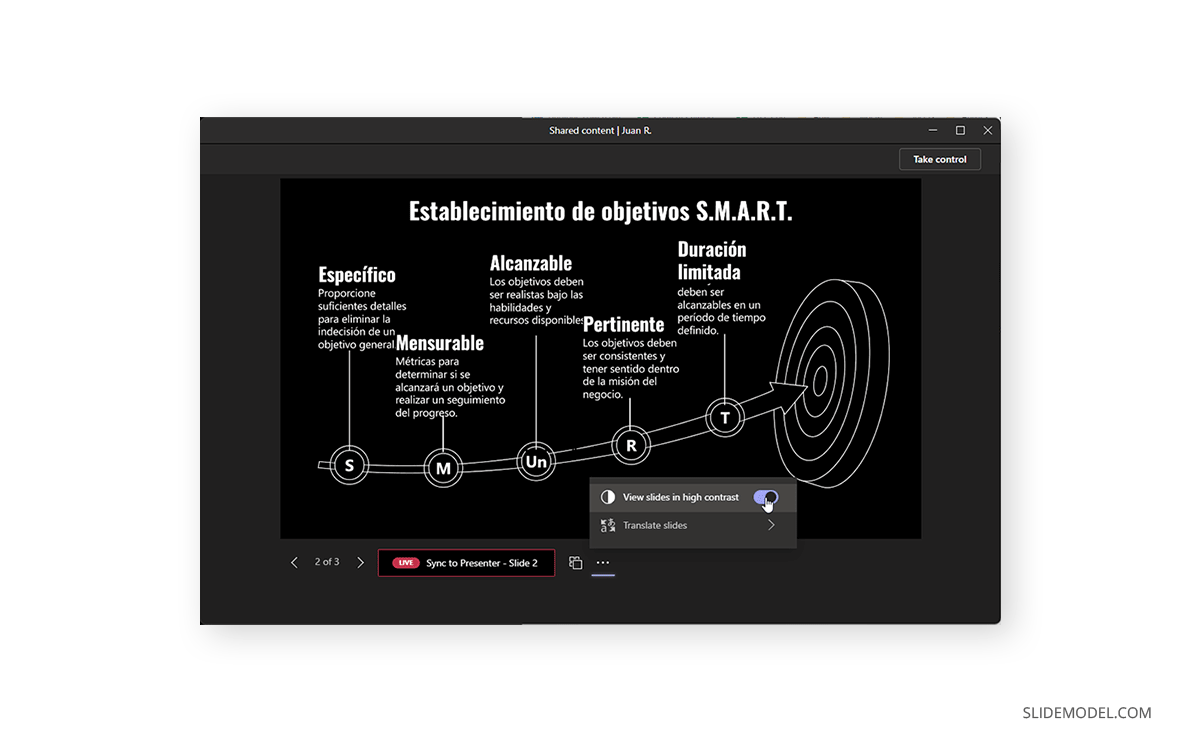
4. Annotate your Slides in Real Time
Like any standard remote meeting app, Microsoft Teams also provides a number of handy annotation options to help you make the most out of your PowerPoint presentations. You can click on Start annotation when sharing your full screen during presentations to start annotating slides.
Powered by Microsoft Whiteboard, this powerful feature enables one or more meeting participants or the presenter to annotate presentations. It can also be a helpful feature when you’re looking to collaborate online during a Live presentation.
5. Pop Out the Window
You can separate the presentation window from the Teams window to make it easier to work with the two. This feature can be handy when working with multiple monitors or separating the two windows from uncluttering your screen. You can use this option by clicking on the Pop-out option from the toolbar during a screen-sharing session.
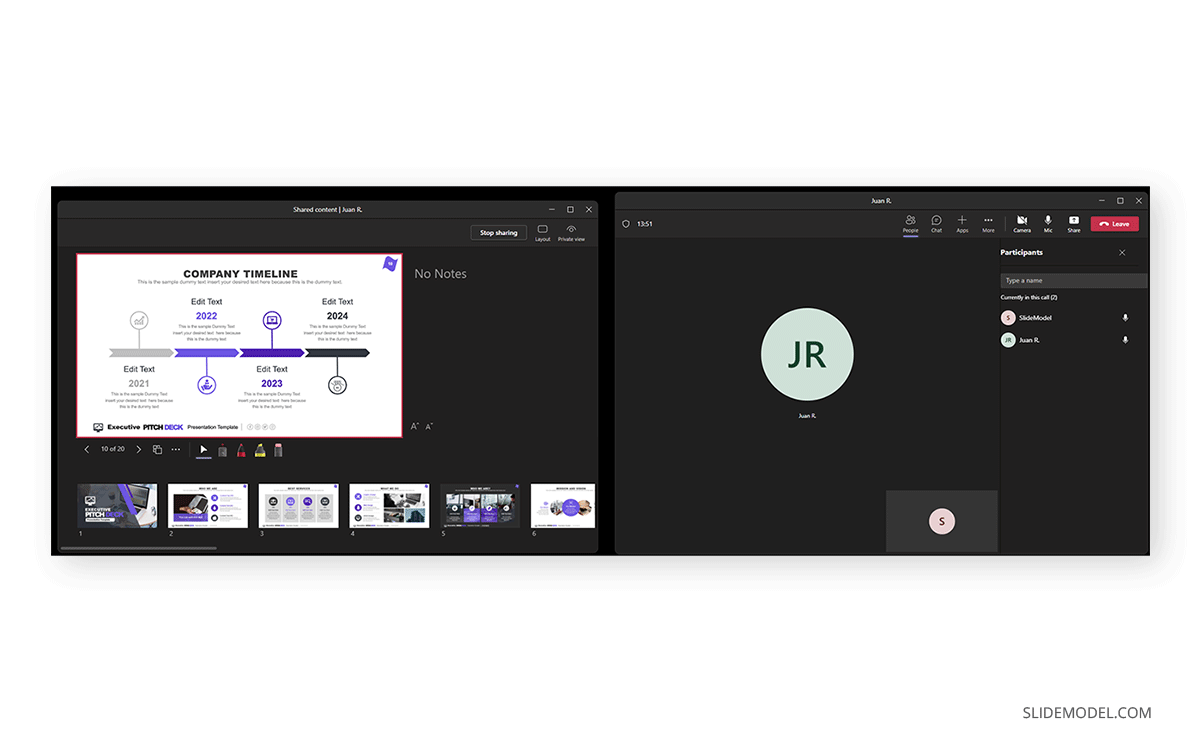
Until now, we have seen how to share presentations specifically on Microsoft Teams. However, there are other ways to share presentations. In our article How to share a PowerPoint presentation we review different methods to share a PPT with others.
How to Stop Presenting on Teams
When presenting your slide deck, you can also present your PowerPoint presentation using any view, be it as a SlideShow or in Normal view. Once you’re done presenting, click Stop Presenting to conclude your session. Furthermore, you can also choose to enable or disable your camera and computer sound when presenting your slides.
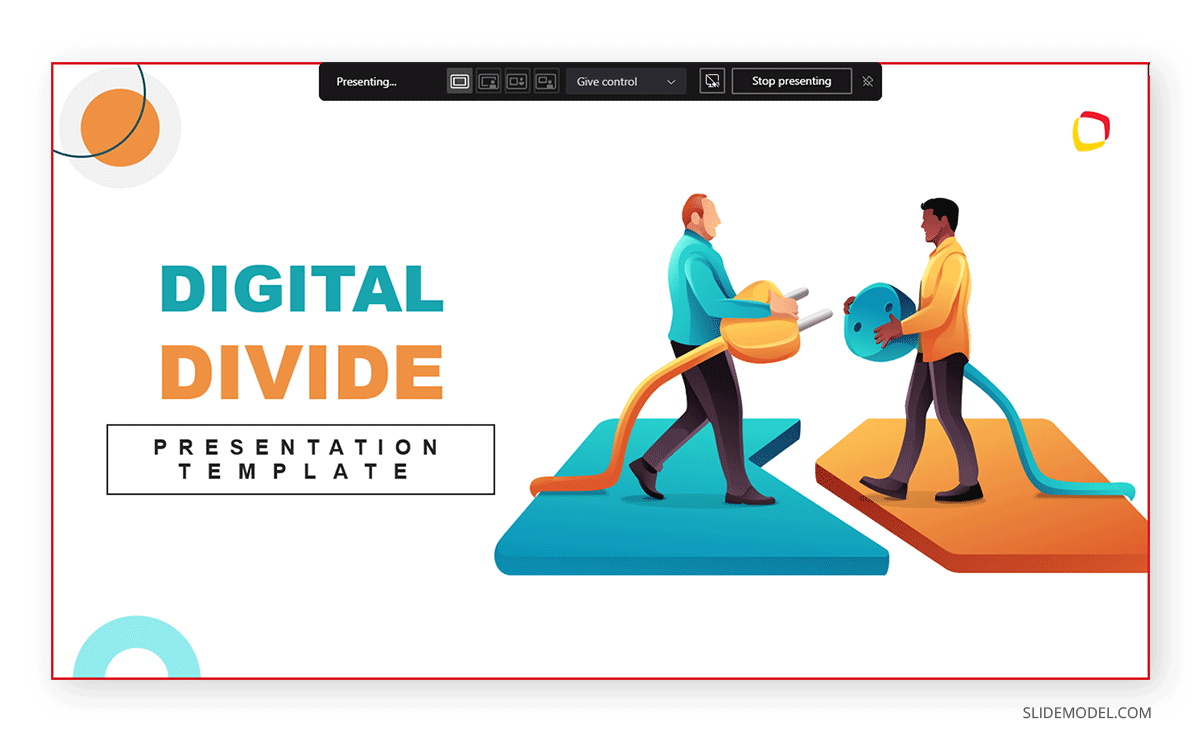
To turn off screen sharing during a remote meeting, you can click Stop Sharing .
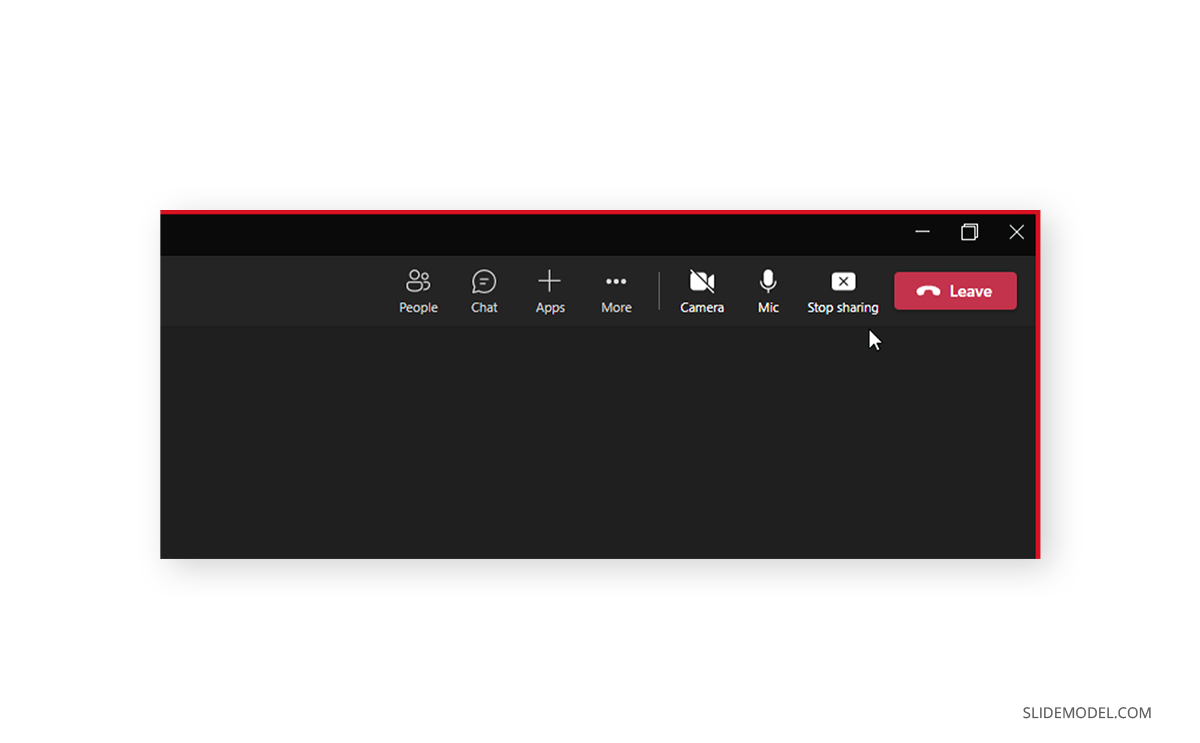
Present in Teams Button in PowerPoint is Missing. How to Fix it?
Some users might have used the Present in Teams option to share a PowerPoint presentation during a meeting. Suppose you are wondering why the Present in Teams button in PowerPoint Presentations is missing. In that case, this option isn’t available for anyone using the free version of Teams, as only users with a paid subscription, such as a Business Standard or Business Premium Plan. Furthermore, you must share your PowerPoint presentation with OneDrive to use this option. To use the Present in Teams option, upload your PowerPoint presentation to OneDrive. You can do this via File > Save As > OneDrive .

Once done, the Present in Teams button will become available to instantly launch your presentation for sharing during a Teams call.
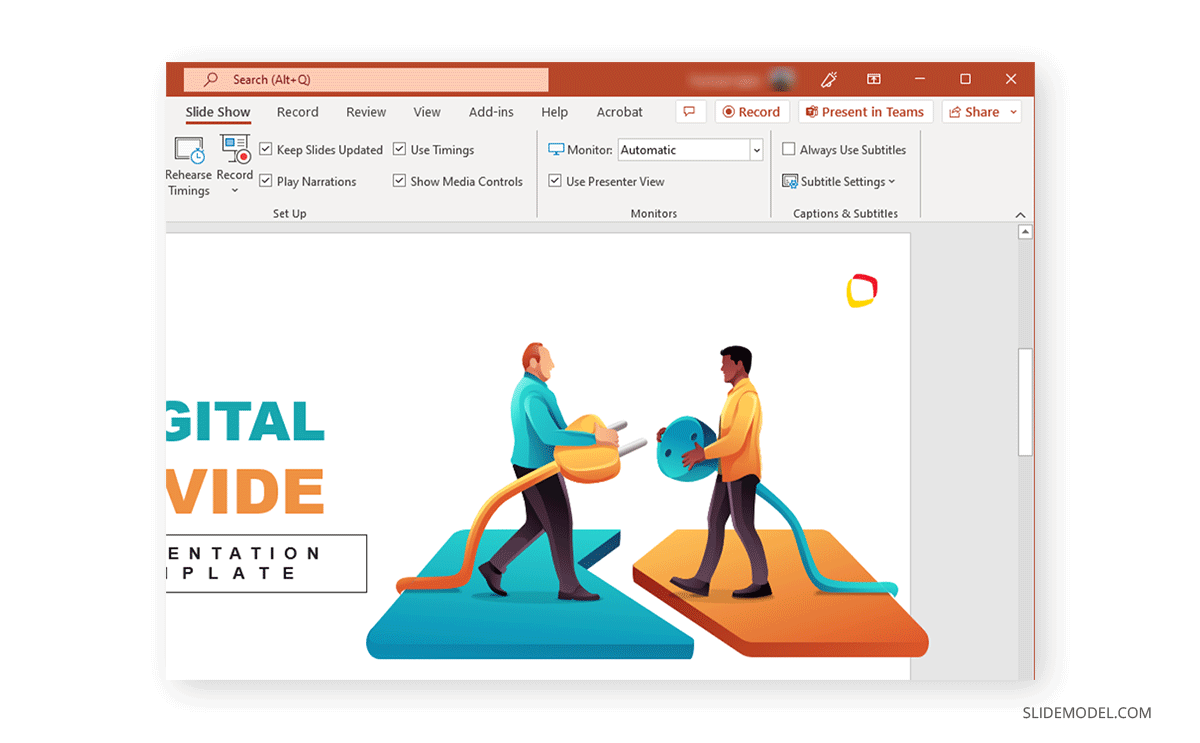
5 Tips to Make your Presentation a Success on Microsoft Teams
Presenting PowerPoint in Teams can require being mindful of a number of things. This includes accounting for brevity to ensure your presentation does not take more than its designated time, using slides that are suitable for remote meetings. Below is a list of 5 tips to make your presentation successful using Microsoft Teams.
1. Check Your Audio and Video Settings
One of the most annoying problems faced during remote meetings is technical failures such as no or low audio quality. This becomes even more annoying when the meeting organizer or a presenter during their session faces the issue, wasting precious time. This is why you must check your audio and video settings beforehand to ensure everything works correctly. If you need to play a video during your session, make a test call with a colleague and get feedback if the sound and video quality are up to the mark.
2. Make Sure Your Slides are Clear and Concise
Presentations delivered via Microsoft Teams will often take place during scheduled remote meetings. This means that you will have to account for the designated time given for your session, which is why you must ensure that your slides are clear and concise.
3. Use Animations and Transitions Sparingly
Since remote meetings will be attended by participants using different types of computers and mobile devices, some animations and transitions might not be suitable. This is because they can cause Teams to slow down, or the slides might not display appropriately via screen sharing. For example, 3D animations , GIF animations , and objects with elaborate PowerPoint animated sequences might cause issues when displayed via Teams.
4. Keep Your Slides on Topic
One of the banes of remote meetings is how a discussion can go off-topic very quickly. This is why it’s best to ensure that your slides remain focused on the topic and additional discussions are discouraged during the presentation session.
5. Use Team Members’ Names Sparingly to Call Out Specific Points
Calling out team members for their opinion or advice during a remote meeting can quickly lead to a very lengthy and off-topic discussion. This is why it’s best to call out team members’ sparingly. If you have been using Teams or other remote meeting apps long enough, you would have learned by now that for some topics, it’s best to ask participants to schedule a separate meeting so that the ongoing discussion remains on track.
Other Issues to Troubleshoot while presenting a PowerPoint presentation on Microsoft Teams
Someone has already set up Teams for your organization’s error
If you’re using a premium subscription for Microsoft Teams managed by your organization’s IT team, you might get an error when logging in to Teams. In such a case, you might get the following error:
“Someone has already set up Teams for your organization.”
If you see the error message mentioned above, this means that your account isn’t ready yet, and you need to contact your organization’s IT team to ask when your account might be ready for use.
We’re sorry–we’ve run into an issue error.
Another prevalent issue is when the following error message appears:
“We’re sorry–we’ve run into an issue.”
This is a generic message, and usually, it can be resolved by clicking the Restart button that appears below the error. In case the issue isn’t resolved after restarting the Teams app, ensure your Internet connection is working. More often than not, the issue is associated with the Internet connection. If the issue persists, you can clear your cache , reinstall Teams or contact your IT support team. The error can also occur if there is an outage affecting Microsoft products or if there is a configuration issue for Microsoft 365 accounts associated with your organization.
Teams is integrated with Microsoft products like PowerPoint, OneDrive, and Office, allowing for seamless and secure sharing of files during remote meetings. It’s widely used in organizations for its ease of use and security features.
To share a PowerPoint file, go to a meeting or conversation, click Attach files, and choose the file from OneDrive or your device. You can send the file to other participants for viewing or editing.
You can present by sharing your screen or PowerPoint window during a Teams call. Click the Share button in Teams, select your PowerPoint presentation, and begin the live presentation.
During a meeting, click Share in the toolbar and choose Screen. This allows you to show everything on your screen, including the PowerPoint presentation and other open apps.
Pros: Easy setup, allows switching between apps. Cons: Potentially exposes sensitive information if you accidentally switch to other windows during the presentation.
You can turn on live captions by clicking More actions -> Turn on live captions. This feature can display captions to assist people with hearing impairments or non-native speakers.
The ‘Present in Teams’ button is available only for users with a paid Microsoft Teams subscription (e.g., Business Standard or Premium) and requires your PowerPoint file to be saved in OneDrive.
Final Words
Using Microsoft Teams to share a presentation file is easy enough. However, when presenting a PowerPoint presentation in Teams, you must decide how to present your slide deck. If you need to switch back and forth between your slides and another document, spreadsheet, or browser window, it might be best to share your entire screen. However, if you wish to focus only on the slide deck, sharing your Window can help you avoid sharing the rest of your screen with the audience.
Like this article? Please share
Meeting, Microsoft Teams, Share Filed under PowerPoint Tutorials
Related Articles

Filed under Business • July 28th, 2022
What is an All Hands Meeting?
The proper meeting format can boost your company’s transparency and help employees align with its core values. In this article, we will introduce the All Hands Meeting model and why it’s a resource you should consider from now on.
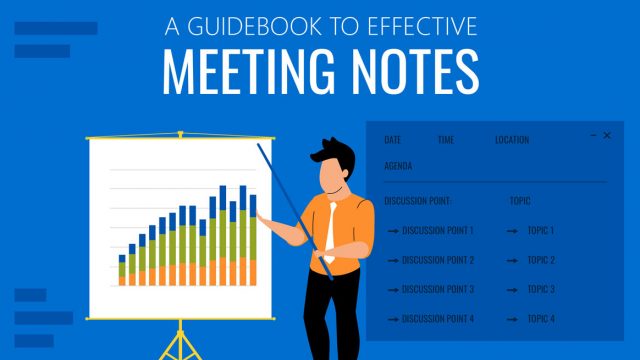
Filed under Business • February 17th, 2022
A guidebook to set Meeting Objectives by taking Effective Meeting Notes
Make an impact in your meetings by applying the science of note-taking. Capture all the valuable information you require by taking effective meeting notes.
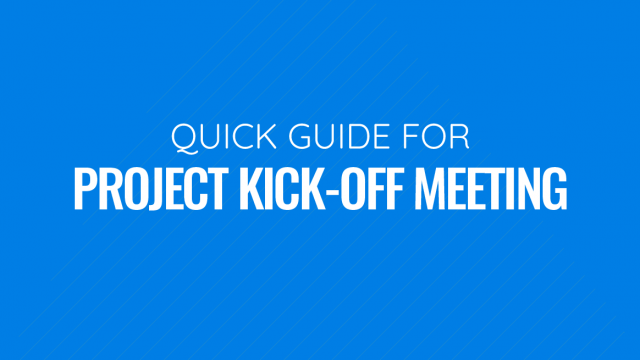
Filed under Business • May 20th, 2021
Quick Guide to Project Kick Off Meetings
Every time a team must begin a project an essential set of meetings must happen to ensure the success of the project. In this blog post we discuss the Project Kick Off Meeting and why it´s so important at the beginning of any new project.
Leave a Reply
How to share PowerPoint slides in Teams meetings
1] share slides in a teams meeting by sharing entire screen, 2] share slides in a teams meeting by sharing the powerpoint window, a] share the slide show window, b] share the powerpoint window in normal view, c] share the powerpoint window in reading view, 3] share slides in a teams meeting with powerpoint live, can i present powerpoint on teams and see notes, how do i share a powerpoint in teams and still see chat, sangeetaghera@twc.
The right way to present a PowerPoint file during a Microsoft Teams meeting

Check out Matt's book!
This is the field guide every Microsoft Teams user out there has been waiting for, covering Teams, chat, meetings, files, and more!
Subscribe to our newsletter!
Stay in the know with goings-on in Office 365, SharePoint, Microsoft Teams and more. It only takes a second, plus it's free!
Get the Periodic Table as a Poster
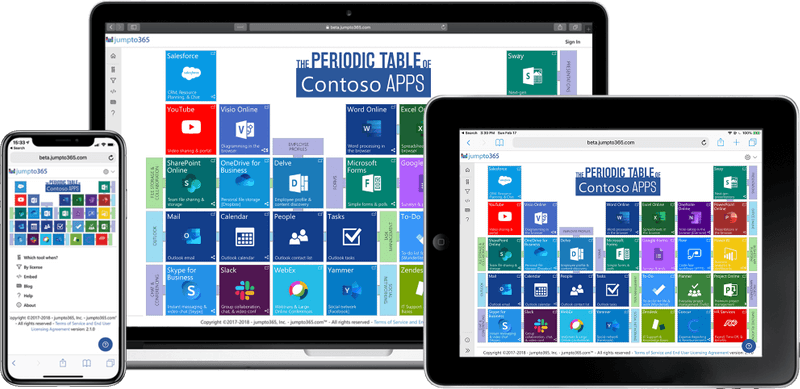
You can have your PPT cake and eat it too
PowerPoint is likely one of the most popular apps shared during a Teams meeting. There’s a reason when you bring up the share options, PowerPoint takes up more than a third of it. People present slides all the time. But are they using PowerPoint to its potential when they use Teams? Most people do not. To view a video version of this post (lots of video demos!), press play below. (You should watch it, actually.)
PowerPoint has a lot of really great features and while this isn’t a PowerPoint best practices post, I do really appreciate PowerPoint for many of its professional features, like smooth transitions (Morph can be amazing), slide notes, non-distracting animations, screen annotations, and especially presenter view.
Well, if you’ve ever tried to present a slide deck in Teams, you’ll know that some of these features can be hard to find depending on which method you use to share your slides. There are three main sharing options and these are the only three I’ll cover today.
The three options—and I’m going to stick to this naming convention throughout the post—are The Teams Built-In Share, Desktop Window Share, and Presenter View Share.
TL;DR: For the most part, you want Presenter View Share. Launch your slideshow like you would normally. Alt-Tab to your meeting and share the window (not the screen) , Alt-Tab back to your presentation, right-click, and select Use Presenter View . That's it! Below is a more in-depth review of this way and the most common other ways to share slide decks during a Teams meeting.
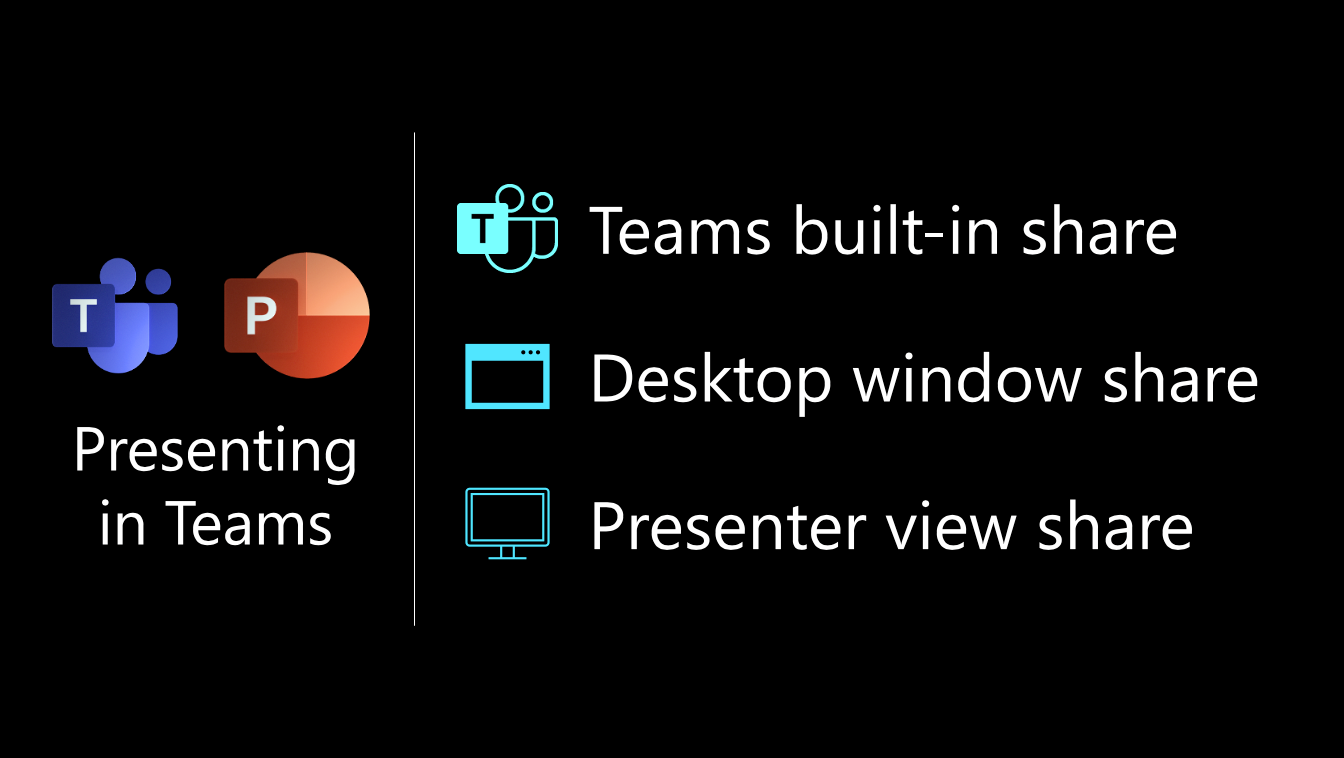
Teams Built-In Share
Teams Built-In Share is the first option we’re going to discuss and it uses the built-in PowerPoint option. The sharing drawer shows you all your recent PowerPoint files. Though note that they’re only ones you’ve accessed in SharePoint or OneDrive; you don’t see anything from your local device or other cloud locations like Google Drive. Whether you know it or not, this method makes use of PowerPoint for the web—or formerly known as PowerPointOnline—so you’re getting the “Lite” version of PowerPoint when you present. That can work in many situations, especially if your slides are simple and straight forward.
There are a couple major upsides to this method. First, everything stays right in Teams and you have full control of your computer and its screen, unlike normal presentation mode with PowerPoint, where it completely takes over your screen. The other is that your viewers can actually choose to jump ahead or backward in your slides at their own pace without impacting what others see, which is a benefit you don’t get from any otherPowerPoint sharing option. You can disable this if you want to keep them on the slide you’re presenting, though. I generally don’t like people being able to jump slides on their own; it's usually more a distraction than a benefit. So for me, this isn’t a compelling feature.
The major downsides to this method are that you’re stuck with PowerPoint Lite: animations and transitions are sometimes really poor—and yes, animations and transitions are incredibly powerful for your message when they’re used correctly. But more importantly to me, you don’t get presenter view, so no annotations, no notes, and you have absolutely no idea which slide or animation is coming up next (unless you practice your slides a lot, but let's be real: you probably cobbled them together right before the meeting). Those downsides are the reason that I never use this method, even if it is right up in my face when I want to share a slide deck in Teams. The only way you’ll find me using Teams Built-In Share is once presenter view is built into PowerPoint for the web.
Desktop Window Share
Desktop Window Share, the second option, is a nice little hack for sharing your presentation from the desktop app, complete with all the slick transitions and animations you’d like. You won’t get presenter view with this method, but you will get safety and comfort of all the full-fledged features in the desktop app and it won’t take up your whole screen while you’re presenting. Though it will include a little chrome in the top toolbar.
This method is similar to what people use when they set up kiosks for people to browse at expos or stores, except in this case, it doesn’t take up the whole screen. To present this way, you need to toggle a setting. Jump into the Slide Show tab in PowerPoint and click Set Up Slide Show . Select Browsed by an individual and click OK.
Now when you present this slideshow, it’ll show your entire slide in its own window, without the rest of PowerPoint showing. It’s like a mini PowerPoint presenter mode. To share this window, jump to your Teams meeting, click Share , and select PowerPoint under the Window section. Handy.
Presenter View Share
Note: This feature seems to have been recently removed from PowerPoint on macOS; I haven't been able to test it on Windows to confirm any impact there. I've reached out to Microsoft for some explanation or insights on this. I'll provide an update when I have one.
And lastly, Presenter View Share is my favorite way to present a slide deck during a Teams meeting and it’s really the subject of this post. Presenter View Share gives you all the features of the desktop app—because that’s what you’re using—including presenter view. That means you get notes and annotations, can see the upcoming slide, and can jump around slides as much as you want.
This technique is actually stupidly simple, but it’s not obvious at all. To share your presentation this way, it works best if you’re only using one monitor. If you have a second monitor, I’d actually recommend disconnecting it. And that’s coming from someone who always uses two monitors. The reason for that is the feature isn't available when you have two monitors because you'll already have presenter view on one of them and you can't share PowerPoint as a window when you have two monitors because the app takes up two windows and becomes essentially disqualified from being shared as a window (the only way to share the slides is by sharing the whole screen, which is less private).
First, have your PowerPoint file open and start the presentation the way you normally would. Now, Alt-Tab (Command-Tab on Mac) back to your Teams meeting and share the PowerPoint window—not the whole screen. Alt-Tab back to PowerPoint. And here’s where the magic happens: right-click on your slide and click Use Presenter View . And that’s it!

Wait, you’re worried that the people on the other end are seeing presenter view? They’re not. In fact, they didn’t even see you right-click because the menu isn’t part of the window. For them, nothing happened. While on your side, you just went from low fi to high fi in a matter of two clicks. From here you can do all the stuff you want through presenter mode and everyone on the other end will only see slides.
So, why do I like this method the most? Because I get to have my cake and eat it too! Sure, the slides take up my whole screen, but that doesn’t stop me from jumping around my device all I want. Alt-Tab is your best friend. If you’re not an Alt-Tab person now, you will be moving forward, because it’s a great little trick for jumping between apps.
That means I can be taking notes about a potential customer in my OneNote app during a demo without them knowing. Or I can check in on the meeting itself to see if someone’s raised their hand or said something I need to respond to. All they’ll ever see is the current slide—even if you see another app on top of it—because all I’m sharing with them is the PowerPoint window.
Edit: Some folks have reported they can actually use two monitors and still are able to share the single presented-view of PowerPoint. I can't confirm this because on Mac, the Use Presenter View isn't available when you have two screens (the option is not available in the right-click menu). That said, if you use multiple monitors, you're a power user. So take 2 minutes to check with a colleagues to test if it still works in your situation to pull this off, but with the multiple monitors you're used to. So if one of your original thoughts was, "I can't not use two monitors", test before you knock it. 🙂
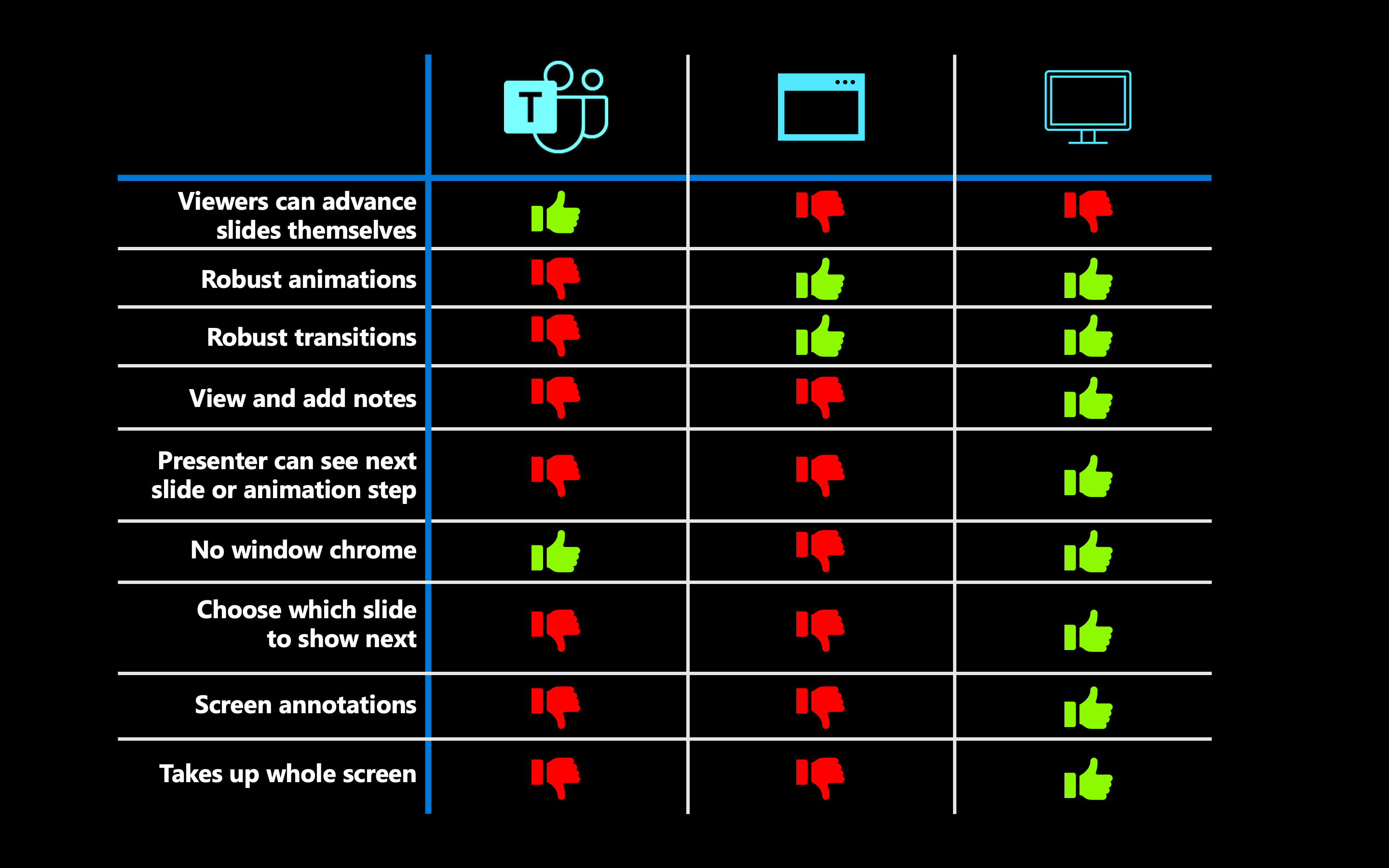
Frankly, I’ll never look back on any other presentation options again. At least until Teams Built-In Share—remember, I really mean PowerPoint for the Web when I say this—finally transitions from PowerPoint Lite to a full-fledged version of PowerPoint. Once that day comes, I may convert. But for now, I’m sticking to the desktop app because it’s a beast.
But what do you think? How do you present slides during Teams meetings? What tips do you have when you’re presenting? Share them in a comment below so others can learn some of your tips and hacks for better meetings in Teams.

Recent blog posts

Periodic Table of Microsoft 365 - 2022 Edition

Send a link to a Power App in an email or communication
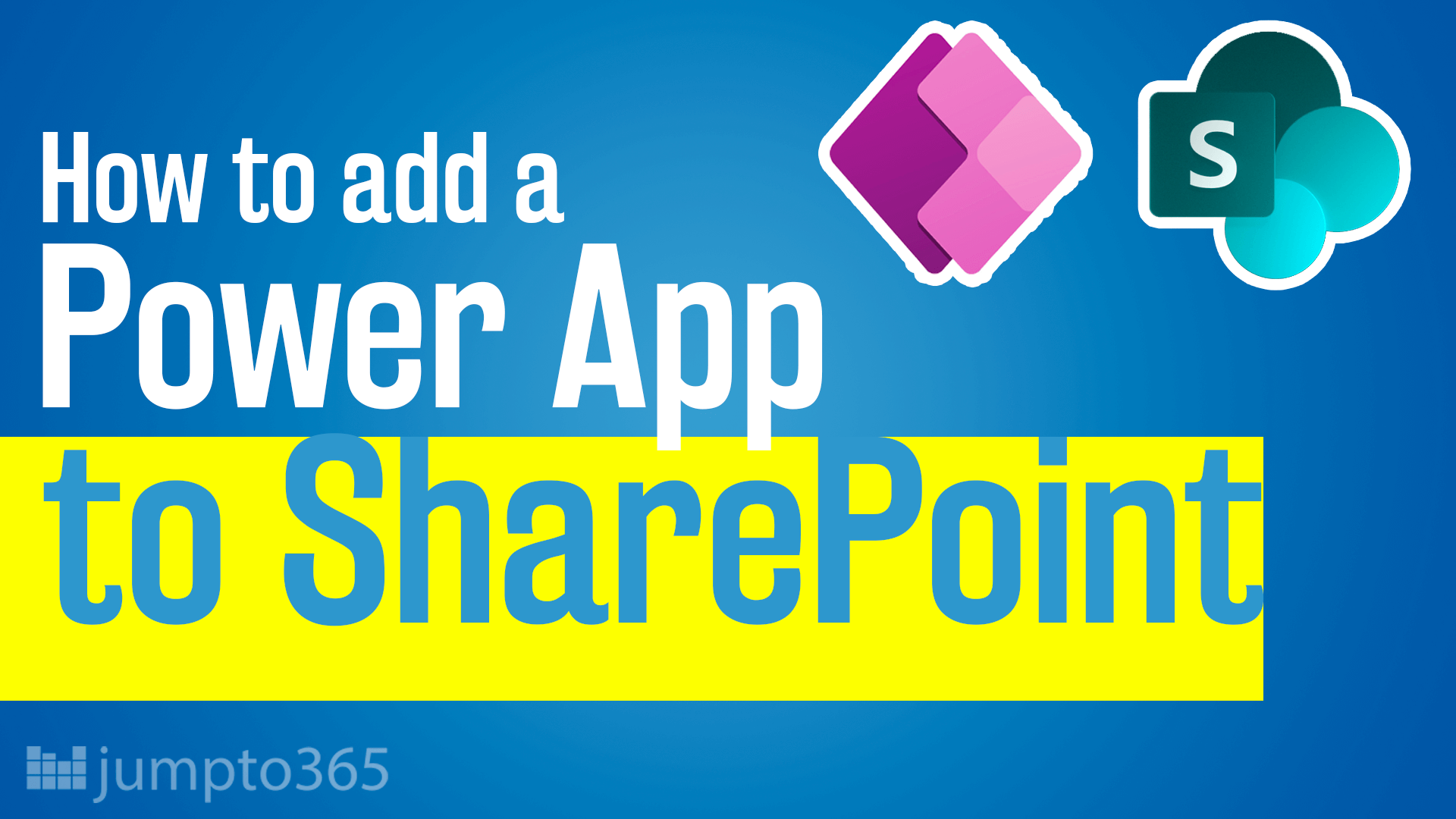
Publish a Power App to a SharePoint page
Obviously you have an opinion, so share it.
[email protected] jumpto365, Inc. PO Box 1960 PMB 24057 Wilmington, DE 19899
- Infographics
- Periodic Table
- Periodic Table Poster
- Other Tables
- Recipes by jumpto365
- Reuse Requirements
- Privacy Policy
- Terms of Service
Tools & Service Descriptions (preview)
Integrations (alpha).
Byte Bite Bit
How to Share a PowerPoint on Teams: Step-by-Step Guide
Navigating the world of online collaboration tools, Microsoft Teams has become essential for many of us. It’s not just about chat or file sharing, though; it’s also a fantastic platform for presentations. To share a PowerPoint on Teams, you simply need to use the Share content button during a meeting. This integration can turn a regular meeting into a dynamic and interactive experience.

Think about how often we scramble to make sure everyone is seeing the right slide or hearing our commentary without a hitch. With PowerPoint Live in Teams, you can not only share your slides but also allow your audience to interact with them. Features like live captions, annotations, and even translation options are at your fingertips, making your presentations accessible and engaging for everyone.
Let’s face it—most of us have been in those meetings where tech issues took center stage. By mastering the art of sharing PowerPoint presentations in Teams, we can ensure our meetings run smoothly. Whether it’s navigating slides, zooming in for detail, or using live captions for clarity, Teams offers robust solutions to enhance our online presentations.
- 1.1 Designing Effective Slides
- 1.2 Incorporating Multimedia Elements
- 2.1 Advanced Presentation Options
- 2.2 Interactive Elements and Accessibility
- 3.1 Effective Screen Sharing in Teams
- 3.2 Collaboration and Communication Tools
- 4.1 Overcoming Common Technical Issues
- 4.2 Tips for Various Technologies
Creating an Engaging PowerPoint Presentation
Let’s dive into strategies for designing effective slides and incorporating multimedia elements to ensure your presentation stands out.
Designing Effective Slides
When it comes to designing slides, clarity is key. Using a high-contrast color scheme improves readability. Dark text on a light background (or vice versa) ensures your slideshow is accessible to everyone, even in dim lighting.
Keeping slides uncluttered helps maintain audience attention. Limit each slide to a few key points. Bullet points and numbered lists organize information efficiently. Split complex topics across multiple slides instead of cramming everything into one.
Font selection matters. Stick with sans-serif fonts like Arial or Calibri; they are easier to read on screen. Keep the font size large enough (at least 24pt for body text) to be visible from the back of a room.
Adding slide notes can help you keep track of important points without overcrowding your PowerPoint file . This feature is especially useful during a Microsoft Teams meeting, allowing you to focus on your delivery while referencing your notes discreetly in the Presenter View .
Incorporating Multimedia Elements
Integrating multimedia elements like videos and audio can make your presentation dynamic and engaging. Embedding a short video clip related to your content can break the monotony of static slides and capture your audience’s attention.
Use animations and transitions sparingly to emphasize important points without overwhelming your audience. Subtle animations like fade-ins or slide-ins can add a professional touch without being distracting.
Interactive tools like the laser pointer in PowerPoint can help direct attention to specific areas of a slide. Encouraging real-time chat and reactions during a Microsoft Teams presentation can foster engagement and make the session interactive.
Using captions is essential for accessibility, especially for attendees with hearing impairments. Enabling captions ensures that all participants can follow along, regardless of any audio issues.
Incorporate these elements thoughtfully to create a cohesive and engaging presentation that keeps your audience interested from start to finish.
Leveraging PowerPoint Live Features
PowerPoint Live in Microsoft Teams offers a variety of robust tools to enhance your presentation experience. Key functionalities include advanced presentation options and interactive elements designed to make your presentations more engaging and accessible.
Advanced Presentation Options
PowerPoint Live is packed with features that offer more than the standard presentation experience. For starters, presenters can navigate slides seamlessly , leveraging features like the Presenter View and Private View . These views enable us to see upcoming slides, speak with notes, and stay organized without distracting the audience.
We can also use OneDrive for Real-Time Collaboration, making it easy for multiple stakeholders to work on a presentation simultaneously. Imagine tweaking those slides while your colleague in another city adds real-time data.
For those using PowerPoint for the Web , the integration ensures all changes sync seamlessly. And setting up the slideshow has never been easier, with options to bookmark slides and rehearse timings. Whether you’re a seasoned pro or a newbie, these tools are designed to make our lives simpler and more productive.
Interactive Elements and Accessibility
Engagement is at the heart of PowerPoint Live. Features like Audience Reactions and Raised Hands let attendees interact with us without disturbing the flow. We can even see chat activity, allowing for a really dynamic and responsive presentation.
Accessibility features are a game-changer. From Screen Readers to High Contrast View , these tools ensure that everyone can participate. Translate Slides lets attendees view translated text in their preferred language—ideal for global teams.
Additionally, options like Magnifying and Panning make it easier for people with vision impairments to follow along. We can truly make our presentations inclusive and engaging for all.
With these tools at our disposal, presenting becomes not just an act of sharing information, but an interactive and inclusive experience for everyone involved.
Mastering Teams Meeting for Presentations
Utilizing Microsoft Teams for presentations requires smart screen sharing and effective communication tools to collaborate seamlessly. Let’s explore how we can ace both these aspects.
Effective Screen Sharing in Teams
To start sharing, we click the Share Button in the Teams Meeting controls. There are multiple options at our disposal. We can share the entire screen , a specific window , or directly choose a PowerPoint file . Sharing the entire desktop is ideal if we need participants to see everything we are doing, but this can be a double-edged sword if there are sensitive materials open.
When presenting a PowerPoint window , the dedicated PowerPoint sharing feature in Teams is a game changer. This option allows us to navigate through slides seamlessly while participants view only the presentation. Another handy tool is the Presenter View , letting us keep annotations and notes to ourselves. Remember, when we share using “PowerPoint Live,” it’s easy to jump between slides without distracting our audience with out-of-place flickers.
Collaboration and Communication Tools
Communication and collaboration are key during remote meetings. Teams Meeting supports various tools making it easier to keep everyone engaged. One of the most powerful features is “Live Annotations.” Using annotation marks, we can highlight important parts of our slides directly. This interactive approach keeps our audience focused and responsive.
The “Give Control” feature is another gem. It allows us to temporarily hand over control to another participant, perfect for when we need input or assistance. Meanwhile, the Chat function ensures smooth communication without interrupting the flow. Participants can drop questions or comments, which we can address at logical breaks.
By smartly leveraging these functionalities, we can transform our presentations into dynamic and interactive sessions.
| Shows everything on your screen | For full transparency when demonstrating software | |
| Shares only the PowerPoint presentation | For focused, distraction-free presentations | |
| Allows another participant to control your screen | When collaboration or technical help is needed |

Technical Aspects and Troubleshooting
Effectively sharing PowerPoint presentations in Microsoft Teams can involve navigating various technical aspects and addressing common issues that users may encounter. We’ll walk through addressing common problems and tips for different devices.
Overcoming Common Technical Issues
Dealing with technical issues while sharing PowerPoint in Microsoft Teams Meetings can be frustrating, but knowing key solutions can help. One common issue is lag during presentations. Ensuring robust network bandwidth by closing other applications and limiting devices on the same network can aid performance.
If participants can’t see your slides, it’s a good idea to check if you’ve clicked “Share” and selected the right PowerPoint file from the “More Options” or “More Actions” menus. Sometimes, switching between Microsoft Edge and Google Chrome can help resolve visibility issues.
For those who interact with your slides at different paces, enable Navigation Arrows to let them move through the presentation independently. If privacy is a concern, avoid sharing your entire desktop to keep irrelevant windows hidden.
To stop sharing, ensure you click “Stop Sharing” to smoothly transition out without disrupting the meeting.
Tips for Various Technologies
Whether using desktops, mobile devices, or CVI devices, proper setup and usage are essential. Desktops provide multiple options like sharing the entire screen, a specific window, or just the PowerPoint via Teams’ sharing options . If running into issues, Presenter View can help manage the slides privately.
On mobile devices , ensure updated Teams apps for seamless camera feed and presentation sharing. Use the Zoom In feature for better readability of detailed slides.
Users of VTC Devices or CVI Devices often face compatibility issues. We recommend ensuring all software is up-to-date and checking compatibility with Teams settings before meetings. For smoother transitions between presenters, incorporate Stop Presenting function to avoid overlap.
Adjusting computer sound settings can also optimize the experience, especially if sharing videos or audio clips embedded within your presentation. Test your setup before meetings for a hassle-free presentation.
Related posts:
- How to Record a PowerPoint Presentation: Step-by-Step Guide for Professionals
- How to Crop a Picture into a Circle in PowerPoint: A Step-by-Step Guide
- How to Print PowerPoint with Notes: A Step-by-Step Guide
- How to Convert PowerPoint to PDF: A Step-by-Step Guide
- How to Change Slide Size in PowerPoint: A Step-by-Step Guide
- How to Save a PowerPoint as a Video for Smooth Presentations
- How to Change Font on All Slides in PowerPoint: A Step-by-Step Guide
- How to Save a PowerPoint as a Video: Step-by-Step Guide
- Where is Word Art in PowerPoint: Quick Guide for Users
- How to Hide a Slide in PowerPoint: Step-by-Step Guide
- How to Rotate Ruler in PowerPoint: Step-by-Step Guide
- How to Blur an Image in PowerPoint: A Step-by-Step Guide
Leave a Comment Cancel reply
Save my name, email, and website in this browser for the next time I comment.

How to Share a PowerPoint in Teams

Microsoft Teams is a powerful platform for collaborating with your colleagues. One of its most useful features is the ability to share files, including PowerPoint presentations. In this article, we’ll take you through the steps you need to follow to share a PowerPoint in Teams, as well as exploring some of the benefits of Teams for PowerPoint sharing, tips for collaboration, troubleshooting common issues, and best practices for sharing PowerPoints with external parties.
Table of Contents
Understanding the Benefits of Sharing PowerPoints in Teams
There are numerous benefits to sharing PowerPoints in Teams. Firstly, by using Teams, you can share your presentation with many people at once, without the need to send individual emails or messages. This helps to streamline communication and collaboration, and saves you a lot of time and effort.
Secondly, Teams allows you to organize your PowerPoint files neatly in channels. This makes it easy for your team to find and access the content they need when they need it. Thirdly, Teams makes it easy to collaborate on a presentation in real-time, by enabling everyone to view and edit the same PowerPoint at the same time. This eliminates email chains and enables your team to work together more efficiently.
Additionally, Teams provides a secure platform for sharing PowerPoints. You can control who has access to your presentation and ensure that sensitive information is not shared with unauthorized individuals. Teams also allows you to track changes made to the presentation, so you can easily revert to a previous version if needed. This feature is particularly useful when working on a presentation with multiple team members.
A Step-by-Step Guide to Sharing a PowerPoint in Teams
Sharing a PowerPoint in Teams is straightforward. Follow these steps:
- Open Microsoft Teams and navigate to the channel where you want to share the PowerPoint. If you haven’t created a channel yet, follow the steps in the next section to do so.
- Click on the ‘Files’ tab in the channel.
- Click on the ‘Upload’ button and select the PowerPoint file you want to share.
- Click on the ‘Share’ button next to the uploaded file.
- Select ‘Share in Teams’ from the dropdown menu.
- Select the people or groups you want to share the PowerPoint with by clicking on the ‘To’ field.
- Add a message if desired by typing in the ‘Add a message’ field.
- Click on the ‘Send’ button to share the PowerPoint in Teams.
It’s important to note that when you share a PowerPoint in Teams, the recipients will be able to view and edit the file in real-time. This means that multiple people can work on the same PowerPoint simultaneously, making collaboration easier and more efficient. Additionally, Teams automatically saves changes made to the file, so you don’t have to worry about losing any progress.
Accessing PowerPoint Files in Microsoft Teams
If you need to access a PowerPoint file that has already been uploaded to Teams, simply follow these steps:
- Open Microsoft Teams and navigate to the channel where the PowerPoint file is located.
- Find the PowerPoint file you need and click on it to open it.
Once you have opened the PowerPoint file, you can view it in Teams or choose to download it to your computer. To download the file, click on the ‘Download’ button located at the top of the screen.
It is also possible to edit the PowerPoint file directly in Teams. To do this, click on the ‘Edit in Teams’ button located next to the ‘Download’ button. This will open the file in the Teams app, where you can make any necessary changes and save them directly to the file.
How to Upload a PowerPoint into Teams
If you need to upload a PowerPoint into Teams for the first time, follow these steps:
- Open Microsoft Teams and navigate to the channel where you want to upload the PowerPoint.
- Click on the ‘Upload’ button and select the PowerPoint file you want to upload.
It’s important to note that the maximum file size for a PowerPoint upload in Teams is 2GB. If your file is larger than this, you may need to compress it or consider using a different file sharing method. Additionally, make sure that your PowerPoint is saved in a compatible format, such as .pptx, to ensure that it can be properly viewed and edited by your team members.
Creating a Channel for Sharing PowerPoints in Teams
If you haven’t already created a channel for sharing PowerPoints in Teams, follow these steps:
- Open Microsoft Teams and click on the ‘Teams’ tab.
- Click on the team you want to create the channel for.
- Click on the ‘+’ button next to the ‘Channels’ header.
- Enter a name for the channel, e.g. ‘PowerPoints’.
- Click on the ‘Create’ button.
Once you have created the channel, you can start sharing PowerPoints with your team members. To do this, simply click on the ‘Files’ tab within the channel and upload your PowerPoint presentation. Your team members will then be able to view and edit the presentation as needed. It’s important to note that you can also set permissions for each file, so you can control who has access to edit or view the presentation.
Inviting Team Members to View Your Shared PowerPoint
If you need to invite team members to view your shared PowerPoint, follow these steps:
- Open Microsoft Teams and navigate to the channel where the PowerPoint is located.
- Click on the PowerPoint file you want to share.
- Click on the ‘Share’ button next to the file.
- Add a message if desired.
It’s important to note that when you share a PowerPoint in Teams, the recipients will be able to view the file. If you need team members to collaborate on the PowerPoint, you can use the ‘Share in Teams’ feature to create a collaborative workspace where everyone can work on the file together in real-time.
Tips for Collaborating on a Shared PowerPoint in Teams
Collaborating on a shared PowerPoint in Teams can be challenging, especially if you have many people working on the same presentation. Follow these tips to make sure your collaboration is as smooth and efficient as possible:
- Use the @mention feature to notify colleagues when you’ve made changes to the PowerPoint, so they can easily find and review them.
- Enable version history to track changes and revert back to previous versions if necessary.
- Use the comments feature to leave notes for colleagues, ask questions, or give feedback.
- Consider using the co-authoring feature, which allows multiple people to work on the same PowerPoint at the same time.
Controlling Access to Your Shared PowerPoints in Teams
It’s important to control access to your shared PowerPoints in Teams, to ensure that only authorized people can view or edit them. Here are some steps you can take to control access:
- Use the ‘Share in Teams’ feature to share your PowerPoint only with people who need to view or edit it.
- Limit the permissions of individual users or groups if necessary, to ensure that they can only view or edit the PowerPoint as appropriate.
- Use the ‘File Permissions’ feature to control who has access to specific files or folders within Teams.
Troubleshooting Common Issues with Sharing PowerPoints in Teams
Here are some common issues you might experience when sharing PowerPoints in Teams, and solutions to these issues:
- If someone can’t access your shared PowerPoint, check their permissions and make sure they have been granted permission to view or edit it.
- If someone is unable to open your PowerPoint, ask them to check that they have the necessary software installed, e.g. Microsoft PowerPoint.
- If you’re experiencing problems uploading a PowerPoint into Teams, try saving the file in a different format, e.g. PDF.
The Importance of Keeping Your Shared PowerPoints Updated and Organized
Keeping your shared PowerPoints updated and organized is crucial to ensuring that your team can find and access the content they need when they need it. Here are some tips for staying organized:
- Use clear and concise file names that accurately reflect the content of the PowerPoint.
- Consider using folders to organize your PowerPoints by topic or project.
- Regularly review and update your shared PowerPoints to ensure that they are accurate and up-to-date.
- Remove outdated or irrelevant PowerPoints to avoid cluttering up your channels.
How to Use Microsoft Teams to Give a Live Presentation with Your PowerPoint
If you want to use Teams to give a live presentation with your PowerPoint, follow these steps:
- Open Microsoft Teams and navigate to the channel where you want to present your PowerPoint.
- Click on the ‘Meetings’ tab and select ‘New Meeting’.
- Type in a name for the meeting, e.g. ‘PowerPoint Presentation’.
- Select the date and time for the meeting.
- Click on the ‘Add participants’ field and select the people you want to invite to the meeting.
- Click on the ‘Schedule’ button to schedule the meeting.
- Click on the ‘Join’ button when it’s time for your presentation.
- Share your screen and open your PowerPoint by clicking on the ‘Present’ button in PowerPoint.
- Deliver your presentation as normal, using Teams to interact with your audience.
Integrating Other Apps and Tools with Your Shared PowerPoint in Teams
Microsoft Teams can integrate with many other apps and tools to enhance your PowerPoint sharing experience. For example, you can integrate with OneDrive to make it easy to access and edit your PowerPoint files, or use third-party apps like Trello to manage your PowerPoint projects. Explore the ‘Apps’ tab in Teams to discover what’s available.
Using Analytics to Track the Performance of Your Shared PowerPoints in Teams
You can use Microsoft Teams to track the performance of your shared PowerPoints by using analytics. Analytics can tell you who has viewed your PowerPoint, how long they spent viewing it, and what pages were viewed most frequently. This information can be used to help you improve your presentations and better understand what your audience is interested in.
Best Practices for Sharing PowerPoints with External Parties through Microsoft Teams
When sharing your PowerPoints with external parties through Teams, it’s important to take extra care to ensure that only authorized people can view or edit them. Here are some best practices to help you do this:
- Use the ‘Guest Access’ feature to invite external parties to Teams channels where your PowerPoints are stored, while limiting their access to other channels or files as appropriate.
- Consider using ‘Advanced Security’ settings to implement additional security measures, such as multi-factor authentication or conditional access.
- Be cautious about sharing sensitive information in PowerPoints with external parties, and use encryption if necessary.
By following these guidelines, you can ensure that your shared PowerPoints are secure and easily accessible to appropriate parties, and that you can collaborate with your team more efficiently and effectively.
By humans, for humans - Best rated articles:
Excel report templates: build better reports faster, top 9 power bi dashboard examples, excel waterfall charts: how to create one that doesn't suck, beyond ai - discover our handpicked bi resources.
Explore Zebra BI's expert-selected resources combining technology and insight for practical, in-depth BI strategies.
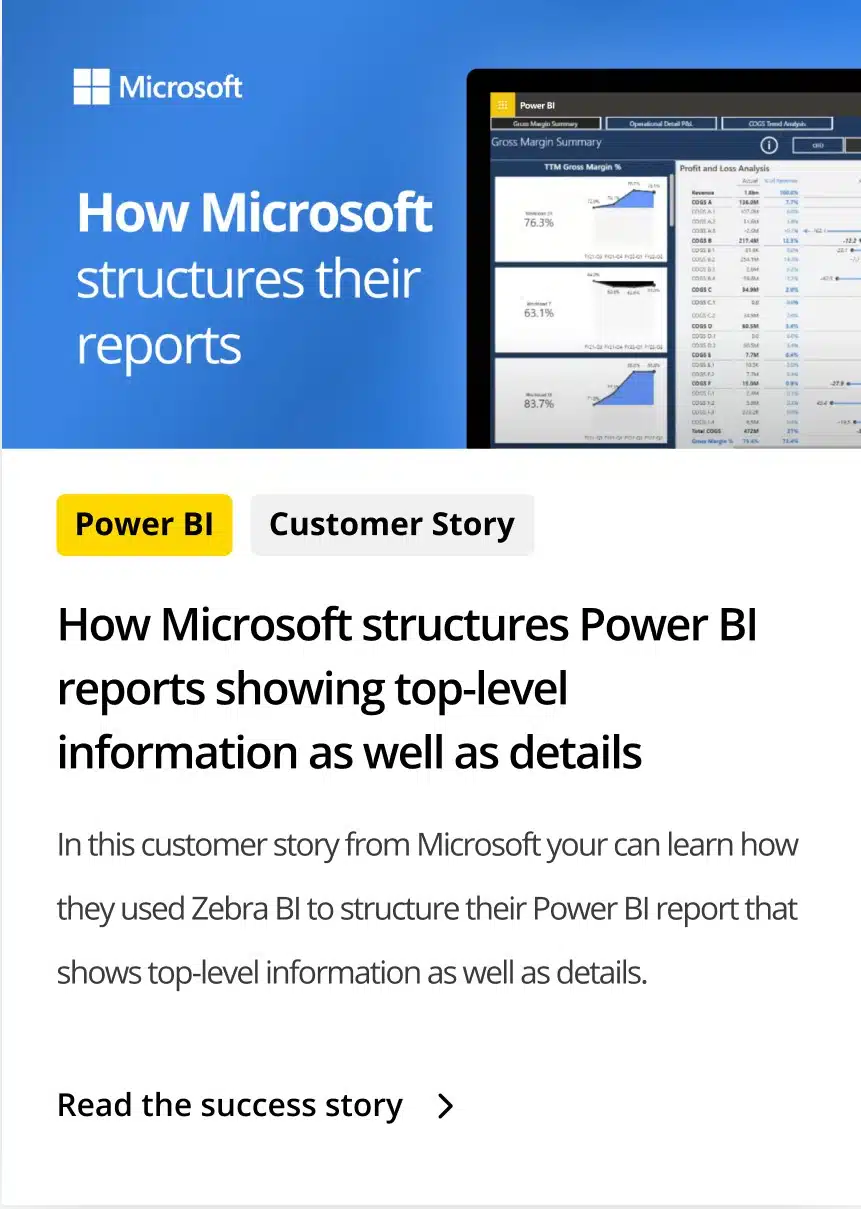
We’ve been experimenting with AI-generated content, and sometimes it gets carried away. Give us a feedback and help us learn and improve! 🤍
Note: This is an experimental AI-generated article. Your help is welcome. Share your feedback with us and help us improve.
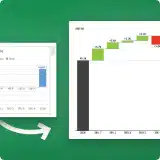

- Our Community
- Our philosophy
- Awards & Certification
- Join our team
- Security Training
- M365 Copilot Webinar
- There are no suggestions because the search field is empty.
- Cyber Security
- IT Projects
- Communications
- Not for Profit
- Engineering
- Case Studies
- What it Costs
- Our Partners
- What Our Clients Say
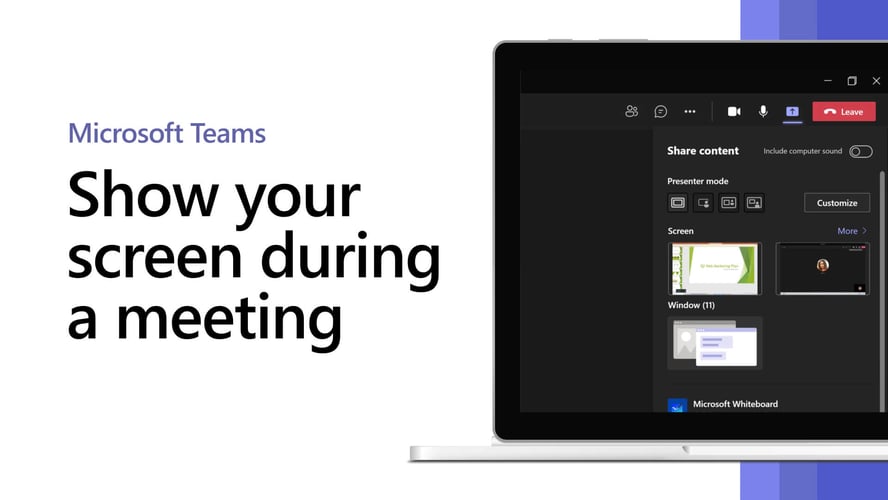
How to share your screen and PowerPoint in Microsoft Teams
Categories: Microsoft 365 , Callan
Sharing your screen, presentations and whiteboards in Microsoft Teams is a great way to make your Teams meetings more effective. And fun… After all, who doesn’t like a cheeky post-meeting game of hangman to secure the office bragging rights for the day? 🏆
Microsoft Teams brought many teams together and has been the tool that brings projects from start to finish. But sometimes, clients will require our IT support services to show them the ropes - especially with sharing screens and PowerPoint presentations in Microsoft Teams.
In this article I’ll show you precisely how you can do these things on Microsoft Teams:
- Share your entire desktop,
- Share a specific window,
- Share a PowerPoint presentation, or
- Share a whiteboard that your team can “collaborate” on 🙂
Sharing Screen Content in Microsoft Teams
You've got a handful of options at your disposal when you want to share content in a meeting, let’s get clear on what the options look like and the best scenario for each. 👇
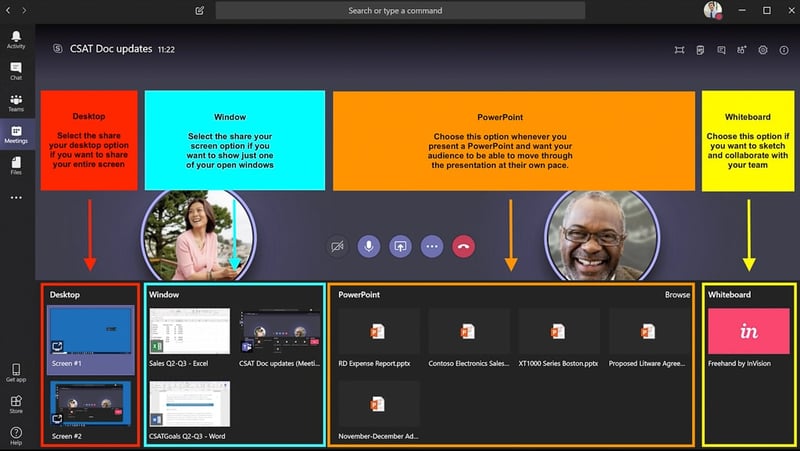
Select the share your desktop option if you want to share your entire desktop screen in Microsoft Teams.
Note: This is the equivalent of having someone look over your shoulder and will include visibility of all your notifications, reminders, and other desktop activity.
Tip : Choose this option when you need to share multiple windows simultaneously. It’s a good idea to disable your notifications or set your computer to do-not-disturb mode first.
Select the share your screen option if you want to present one of your open windows in the Microsoft Teams app. An example might be a spreadsheet, webpage or word doc.
Note : This option will exclude notifications, reminders or desktop activity outside the shared window.
Tip : Choose this option if you only need to share one thing and want to keep the rest of your screen private.
Microsoft Teams have built in the capability of sharing your PowerPoint presentations. This interactive method of sharing allows your team to interact with your presentation by skipping forward and backwards through your slides, without disrupting your flow as the presenter.
Tip : Choose this option whenever you share a PowerPoint in Microsoft Teams and want your audience to be able to move through the presentation at their own pace.
Note : As the presenter, you can disable the ability for others to browse through the slides if you wish.
Each Teams meeting has a whiteboard where meeting participants have space to ink together. Select the share your whiteboard option if you want to open the virtual whiteboard that everyone can collaborate on in Microsoft Teams.
Tip: Choose this option if you want to brainstorm with your team and have your ideas attached to your meeting. Also great for a quick game of hangman, tic tac toe or dots and crosses. 🙂
How to share your screen in Microsoft Teams
- While in a meeting, chat or group chat click the share icon
- Choose if you’d like to share your entire desktop or just one specific window
- When you’re done sharing click the stop sharing Icon
How to share your PowerPoint presentation in Microsoft Teams
- Choose from one of your recently opened PowerPoint slide presentations. Alternatively, click Browse to navigate to your PowerPoint file
- Your team members will be able to navigate through your presentation by default. (Optional turn off this feature by clicking the eye icon to turn off participant navigation). And that's how to share PowerPoint on Teams
- And when you’re done sharing, click the stop sharing icon
How to share your whiteboard in Microsoft Teams
- Select the whiteboard option from the menu
- Everyone will be able to grab a pen and interact with the whiteboard
If you need further help with PowerPoint or any of the Microsoft 365 productivity tools, your friendly neighbourhood IT support guys are willing to help.
Microsoft Teams Training Resources
- Microsoft Teams Quick Start Guide for New Users
- Microsoft Teams for Beginners: 101
You may also be interested in

Microsoft Teams Quick Start Guides
Drop your details below and tell us where to send your quick start guide - we'll also include a copy of our Microsoft Teams for Beginners 101 guide too.
Turn that IT frown upside down
IT isn’t supposed to distract you from the important stuff. It’s supposed to enable you to do more of it, more efficiently. And that’s our sole purpose at Office Solutions IT – delivering IT support services that take care of the complex business of managing IT, so you can focus on your business. Get in touch and find out more.
Call us on 1300 349 195 Email us [email protected] Schedule a call

Recent Blog Posts
- How to Login
- Use Teams on the web
- Join a meeting in Teams
- Join without a Teams account
- Join on a second device
- Join as a view-only attendee
- Join from Google
- Schedule a meeting in Teams
- Schedule from Outlook
- Schedule from Google
- Instant meeting
- Add a dial-in number
- See all your meetings
- Invite people
- Meeting roles
- Add co-organizers
- Hide attendee names
- Tips for large Teams meeting
- Lock a meeting
- End a meeting
- Manage your calendar
- Meeting controls
- Prepare in a green room
- Present content
- Share slides
- Share sound
- Apply video filters
- Mute and unmute
- Spotlight a video
- Multitasking
- Raise your hand
- Live reactions
- Take meeting notes
- Join a breakout room
- Customize your view
- Laser pointer
- Cast from a desktop
- Use a green screen
- Join as an avatar
- Customize your avatar
- Use emotes, gestures, and more
- Get started with immersive spaces
- Use in-meeting controls
- Spatial audio
- Overview of Microsoft Teams Premium
- Intelligent productivity
- Advanced meeting protection
- Engaging event experiences
- Change your background
- Meeting themes
- Audio settings
- Manage attendee audio and video
- Reduce background noise
- Voice isolation in Teams
- Mute notifications
- Use breakout rooms
- Live transcription
- Language interpretation
- Live captions
- End-to-end encryption
- Presenter modes
- Call and meeting quality
- Meeting attendance reports
- Using the lobby
- Meeting options
- Record a meeting
- Meeting recap
- Play and share a meeting recording
- Delete a recording
- Edit or delete a transcript
- Customize access to recordings or transcripts
- Switch to town halls
- Get started
- Schedule a live event
- Invite attendees
- organizer checklist
- For tier 1 events
- Produce a live event
- Produce a live event with Teams Encoder
- Best practices
- Moderate a Q&A
- Allow anonymous presenters
- Attendee engagement report
- Recording and reports
- Attend a live event in Teams
- Participate in a Q&A
- Use live captions
- Schedule a webinar
- Customize a webinar
- Publicize a webinar
- Manage webinar registration
- Manage what attendees see
- Change webinar details
- Manage webinar emails
- Cancel a webinar
- Manage webinar recordings
- Webinar attendance report
- Get started with town hall
- Attend a town hall
- Schedule a town hall
- Customize a town hall
- Host a town hall
- Use RTMP-In
- Town hall insights
- Manage town hall recordings
- Cancel a town hall
- Can't join a meeting
- Camera isn't working
- Microphone isn't working
- My speaker isn’t working
- Breakout rooms issues
- Immersive spaces issues
- Meetings keep dropping

Engage your audience with presenter modes in Microsoft Teams
Meeting participants tend to be more focused and have a better experience when they see a presenter along with a presentation. An interactive presenter also helps guide an audience along with visual cues while reducing information overload. By using a presenter mode such as Standout , Side-by-side , or Reporter in a Teams meeting instead of sharing screen or window content only, you become a more engaging and integral part of your presentation. The following examples show how each presenter mode appears to an audience:

Use a presenter mode

Under Presenter mode , choose the mode that you want. Also, be sure that your camera is turned on.
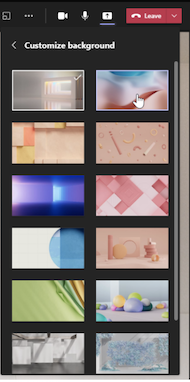
To start your presentation, choose to share your S creen or Window on your PC or device.
Note: Using interactive presenter modes with PowerPoint Live will soon be available.

Note: Presenter mode customization is available as part of the public preview program and might undergo further changes before being released publicly. To get access to this and other upcoming features, switch to Teams public preview .
Presenter modes also allow presenters to customize how their content will be oriented on screen and adjust the size of the video to better fit the presentation.
Customize video display
1. Use the Position buttons in the preview window to direct where videos will appear in relation to the content.

2. Enlarge or reduce video size using the Size slider. Slide the circle to the left to reduce the size of a video, or to the right to enlarge the size of a video.
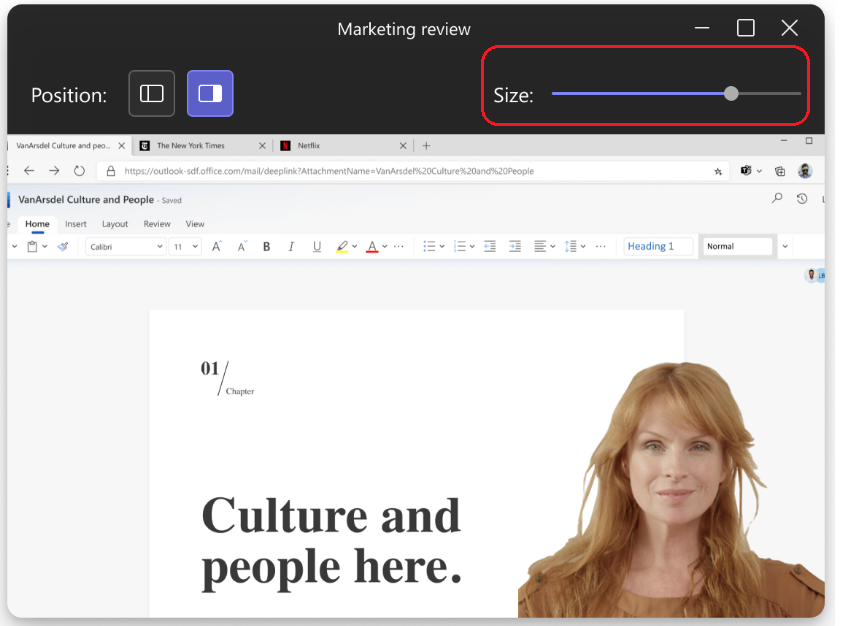
More things to know
Interactive presenter modes are only available for the desktop version of Teams.
Meeting attendees using the mobile or online versions of Teams will see a shared window or screen and presenter video separately.
When you use an interactive presenter mode, a small, moveable picture-in-picture window pops up to show you what your audience sees. If you close this window and need it again, restart the presenter mode.
Related links
Meetings in Teams Schedule a meeting in Teams Share content in a meeting Introducing PowerPoint Live in Teams

Need more help?
Want more options.
Explore subscription benefits, browse training courses, learn how to secure your device, and more.

Microsoft 365 subscription benefits

Microsoft 365 training

Microsoft security

Accessibility center
Communities help you ask and answer questions, give feedback, and hear from experts with rich knowledge.

Ask the Microsoft Community

Microsoft Tech Community

Windows Insiders
Microsoft 365 Insiders
Was this information helpful?
Thank you for your feedback.
Free All-in-One Office Suite with PDF Editor
Edit Word, Excel, and PPT for FREE.
Read, edit, and convert PDFs with the powerful PDF toolkit.
Microsoft-like interface, easy to use.
Windows • MacOS • Linux • iOS • Android
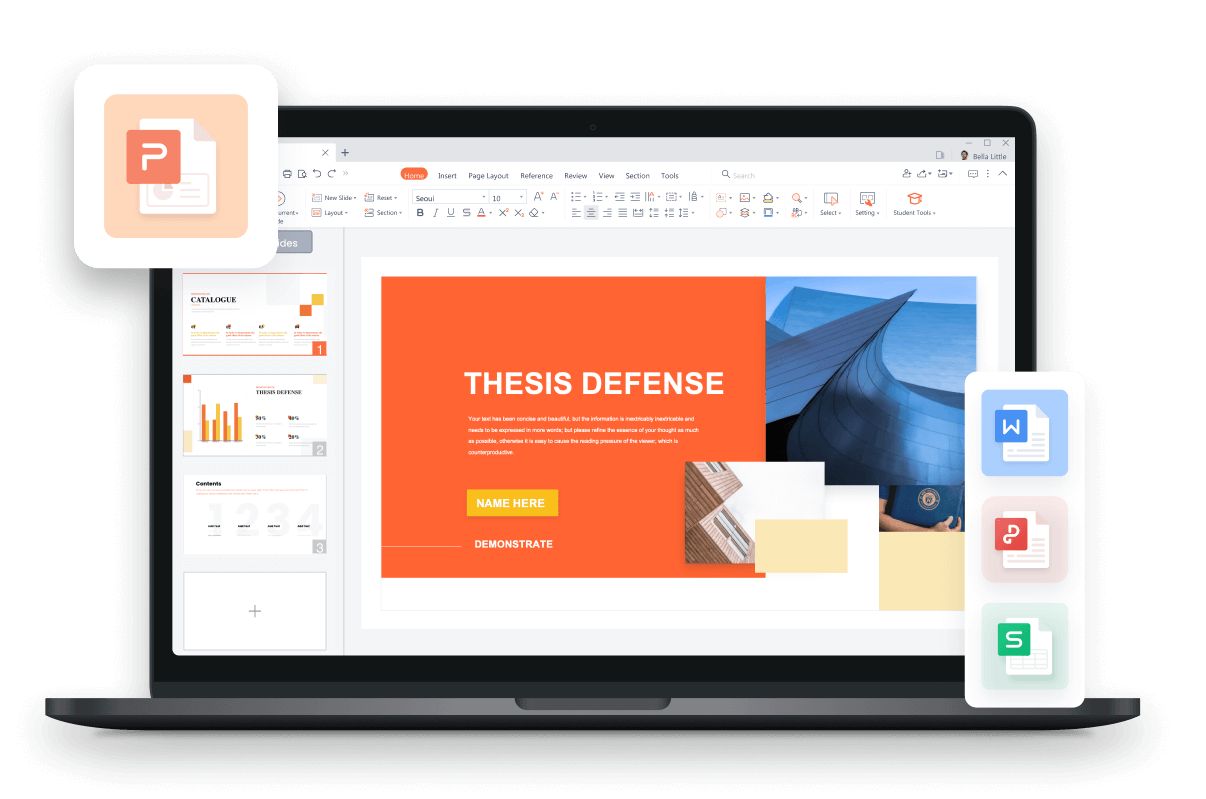
- Articles of PPT
How to Share PowerPoint On Teams without Showing Notes
Microsoft Teams help individuals to conduct meetings online and collaborate conveniently. You can also present a PowerPoint presentation with your team using Microsoft Teams. However, many people need to learn how to share PowerPoint on Teams.
Do you want to share PowerPoint presentations on Teams without showing Notes? This article will help you to learn how to share PowerPoint on Teams without showing notes. Stay with us.
Part 1. How To Share PowerPoint on Teams Without Showing Notes?
You can easily share your PowerPoint on Teams in simple steps. You can share the PowerPoint in Slide View, Presenter View, or PowerPoint Live. Let's discuss each method in detail.
Method 1. Share the PowerPoint Slide View
This is the most straightforward method to share PowerPoint on Teams. Follow these steps to share your presentation on Teams.
Step 1: Open your presentation in PowerPoint that you want to share.
Step 2: Connect with your team using Teams or start a new meeting.
Step 3: Go to the Share option in Microsoft Teams.
Step 4: Select the Window option.
Step 5: Choose the PowerPoint presentation window to share and click the Share button.
Step 6: Go to the PowerPoint again and select the Slide Show option or press the F5 key to present the presentation in full screen.
Using this option, you can present your presentation in full screen on Teams. Your team members will not see the notes. However, the notes will be hidden from you also. Also, you won't be able to see Team controls.
Method 2: Using The Presenter View
If you have two screens, you can use the Presenter view option to share your presentation on Teams. Follow these steps to use this method.
Step 1: Open your presentation in PowerPoint.
Step 2: Select the Slide Show option in PowerPoint or press the F5 key.
Step 3: Select Use Presenter View in the monitor section.
Step 4: Press F5 or select Slide Show again from PowerPoint.
Step 5: Access your Teams meeting from Teams or Calendar or start a New Meeting.
Step 6: Select Screen Share from the Teams sharing tray and then select the monitor you are using.
Step 7: Click the Share button to share your presentation on Teams.
This method allows you to see the notes with each slide while sharing the presentation. However, you can not see different options and tools of Teams and can not interact with your team members.
Method 3. Using PowerPoint Live
PowerPoint Live allows you to present your presentation directly from within the Teams. It gives the Presenter and the audience a unique and engaging experience. You can share your presentation using PowerPoint Live using these steps.
Step 1: If you are in a Teams meeting, select Share and select the PowerPoint presentation in the PowerPoint Live option. If you cannot see your required presentation, browse for your desired presentation in OneDrive or My PC.
Step 2: If your presentation is already opened in PowerPoint, Go to the File menu and select Share, and then click the Present Online option.
Step 3: If you are using PowerPoint for the web, select Present and then select Present in Teams.
Using PowerPoint Live helps you to access all the options and tools of Teams. You can easily engage with your audience using different opinions available. You can turn Chat on or off and see raised hands by the audience in real-time. You can also customize other Layout options for your presentation.
Part 2: Free Alternative Choice-WPS Office
WPS Office is the best office solution in the modern world. It is a powerful office productivity suite used by millions nowadays. Professionals and students use WPS Office to create impressive documents, analytical spreadsheets, stunning presentations, etc. WPS Office is an all-in-one productivity suite that contains the following applications and tools.
Writer - to create Word documents, CVs, resumes, and much more
Spreadsheet - to create Excel sheets used for data analysis and insights
Presentation - used to create impressive PowerPoint presentations
AirPage - online document collaboration tool
PDF - to create, edit, and open PDF documents
Besides these, WPS Office also has Teams, WPS Cloud, document conversion tools, and many more practical applications.
Amazing and Unique Features of WPS Office
WPS Office has powerful and unique features and functions, making it the best alternative to Microsoft Office, Libre Office, and other office suites. Some of the special and modern features and functions of WPS Office are listed below.
Free To Use
The most in-demand and unique feature of WPS Office is its free availability for all platforms. Users can use WPS Office on Windows, Mac, Linux, Android, and iOS devices free of cost.
Templates Library
WPS Office has a vast collection of attractive templates in its applications. You can use these built-in templates to design a CV, resume, presentation, etc. There is no need to create your documents from scratch. You can use any of the suitable templates and create your documents easily.
WPS Productivity Tools
WPS also contains many helpful productivity tools included in the Office suite. You can easily convert between different document formats. There is no need to use third-party conversion tools. You can also insert or remove watermarks from your document. There is a Screen Recorder in WPS Office, which helps you to record screens, record a particular window, or record using the Webcam of your PC.
Use Word, Excel, and PPT for FREE, No Ads.
Edit PDF files with the powerful PDF toolkit.
Microsoft-like interface. Easy to learn. 100% Compatibility.
Boost your productivity with WPS's abundant free Word, Excel, PPT, and CV templates.
WPS Academy
WPS Academy offers free easy to understand office tutorials. It provides free video tutorials regarding different features and functions of WPS Office and how to use them. These tutorials help you to master your skills in Excel, PowerPoint, Writer, and PDF applications.
Picture To PDF
This tool helps you to convert your images to PDFs. You can take pictures of the documents and then can generate PDF documents quickly. This feature lets you scan an entire book and make a PDF from all the scanned photos.
Auto Backup Feature
WPS Office also offers an Auto Backup feature. This feature helps you to create a local backup of all your documents. You can create your Word, PowerPoint, Excel, and document backups. You can also save this backup to WPS Cloud.
You can create a team of all your teammates using WPS Team. WPS Teams help you to interact with your colleagues easily. You can share your files. You can also track changes and see all files' version history.
How to Download WPS Office?
You can easily download WPS Office from its official website. Go to the website and click the Free Download option. After the download, run the installer file, and WPS Office will be installed on your PC.
Frequently Asked Questions
1. how to share powerpoint presentations on teams without displaying speaker notes.
You will need two screens to use the Presenter view to show the presentation without showing notes.
2. How do I change the Presenter mode in PowerPoint?
Go to the Slide Show option from the main menu in PowerPoint and check the Presenter View checkbox to use the presenter mode in PowerPoint.
How To Share PowerPoint On Teams Without Showing Notes - Wrap Up
You can easily share your PowerPoint presentation on Teams. You can use the Slide Show option or use the Presenter View to share your PowerPoint presentation. You can also use the PowerPoint Live option to share your PPT on Teams. This article provided you with a detailed tutorial on how to share PowerPoint on Teams without showing notes.
WPS Office is also a powerful solution that lets you share your PowerPoint presentation on WPS Teams in simple and easy steps. You can download WPS Office for free from its official website.
- 1. How to Use Teams Presenter Mode for PowerPoint Presentations
- 2. How to Share PowerPoint on Zoom Without Showing Notes (In Easy Methods)
- 3. How to Share PowerPoint Without Showing Notes (Step-By-Step)
- 4. How to Use Microsoft Copilot in Teams (Step-by-Step)
- 5. How to Share PowerPoint on Teams: A Step-by-Step Guide
- 6. Zoom: Sharing PowerPoint without Showing Notes On Mac

15 years of office industry experience, tech lover and copywriter. Follow me for product reviews, comparisons, and recommendations for new apps and software.

IMAGES
VIDEO
COMMENTS
Present your slides. If you're already in a Teams meeting, select Share and then under the PowerPoint Live section, choose the PowerPoint file you're wanting to present. If you don't see the file in the list, select Browse OneDrive or Browse my computer. If your presentation is already open in PowerPoint for Windows or Mac, go to the file ...
If you need to present in an online meeting, you can show your PowerPoint slides right from a Microsoft Teams meeting.If you're a presenter:1. Select Share c...
Present your slides. If you're already in a Teams meeting, select Share and then under the PowerPoint Live section, choose the PowerPoint file you're wanting to present. If you don't see the file in the list, select Browse OneDrive or Browse my computer. If your presentation is already open in PowerPoint for Windows or Mac, go to the file ...
If you're leading a presentation and need to share your PowerPoint slides during a Microsoft Teams meeting, here's how: • Once your meeting is active, select...
The seven options are: Share your entire screen/desktop. Share the Slide Show window. Share the editing window with a clean look. Run the Slide Show in a window and share that window. Use the PowerPoint sharing option in Teams. Use Presenter View to show the audience your slides while you see Presenter View. Present with your video beside your ...
Method #3: Share PowerPoint Window to Present Your Slides. If you intend to hide parts of your screen, you can simply share the relevant PowerPoint window so that your audience can only view the presentation. During a Live call, click the Share button and select your screen or window to share.
Expand your view by opening shared content in a separate window during your Teams meetings. To open shared content: Join your meeting from Teams for desktop. When another presenter shares content in the meeting window, select Open in new window from the meeting toolbar. To minimize content, select X.
Go to PowerPoint and select the Slide Show tab in the top ribbon. Click on the Set Up Slide Show button. Select Browsed by an individual (window) under Show type and click on OK. Click on the play ...
PowerPoint Live transforms your presenting experience - only in Microsoft Teams. PowerPoint is used around the world to share compelling stories—from personal to professional. As the world shifted to working remotely, we all faced new challenges presenting without a live audience. Reading the room, seeing people's expressions, and natural ...
Discover more ways to share content in Microsoft Teams. Jen Bradley from the #MicrosoftTeams team talks about some of her favorite ways to share content in a...
First, have your PowerPoint file open and start the presentation the way you normally would. Now, Alt-Tab (Command-Tab on Mac) back to your Teams meeting and share the PowerPoint window—not the whole screen. Alt-Tab back to PowerPoint. And here's where the magic happens: right-click on your slide and click Use Presenter View.
To share a PowerPoint on Teams, you simply need to use the Share content button during a meeting. This integration can turn a regular meeting into a dynamic and interactive experience. Think about how often we scramble to make sure everyone is seeing the right slide or hearing our commentary without a hitch. With PowerPoint Live in Teams, you ...
Click on the 'Files' tab in the channel. Click on the 'Upload' button and select the PowerPoint file you want to share. Click on the 'Share' button next to the uploaded file. Select 'Share in Teams' from the dropdown menu. Select the people or groups you want to share the PowerPoint with by clicking on the 'To' field.
Microsoft Teams has a built-in share option, so you don't have to use PowerPoint software during meetings. Step 1: Join a Teams meeting. Step 2: Hit Share to start sharing. Step 3: Go to PowerPoint and select a recent presentation or click on browse to upload a new one. The program will display your presentation using PowerPoint on the Web in ...
Learn how you can easily pass control back and forth when you choose to share directly present a PowerPoint file in your Teams Meeting. By selecting a file ...
How to share screen in Microsoft Teams. Watch on. While in a meeting, chat or group chat click the share icon. Choose if you'd like to share your entire desktop or just one specific window. When you're done sharing click the stop sharing Icon. How to share your PowerPoint presentation in Microsoft Teams.
Share your PowerPoint presentation with others. Windows macOS. Select Share. If your presentation isn't already stored on OneDrive, select where to save your presentation to the cloud. Choose a permission level, like Anyone with a link, or maybe just people in your company. You can also control if people can edit or just view the doc.
I had a Teams meeting with multiple people (~20-30 people) who joined. For the meeting (I created), I shared my screen and chose the PowerPoint file that I had opened to share. Everyone could see the PowerPoint File, but when I entered Presentation Mode it still showed the main PowerPoint editor screen on everyone else's screen but mine.
Here's a detailed step-by-step guide on how you can share PowerPoint live in team: Step 1: Navigate to the share button if you are already in a Teams meeting. After selecting the Share, click on the PowerPoint Live section. Step 2: Under the PowerPoint Live section, you must choose the PowerPoint file you want to present to the team.
Learn how to share PowerPoint slides on the Teams mobile app in a meeting. Useful if you're working outside or need a second screen. This video will go throu...
After your meeting starts, at the upper-right corner of Teams, select Share content to choose a Presenter mode and other options. Meeting presenter modes and options. Under Presenter mode, choose the mode that you want. Also, be sure that your camera is turned on. Before starting the presentation, select Customize and choose a background image.
Step 1: Open your presentation in PowerPoint that you want to share. Step 2: Connect with your team using Teams or start a new meeting. Step 3: Go to the Share option in Microsoft Teams. Step 4: Select the Window option. Step 5: Choose the PowerPoint presentation window to share and click the Share button.